Video: NCIA Today – June 11, 2021
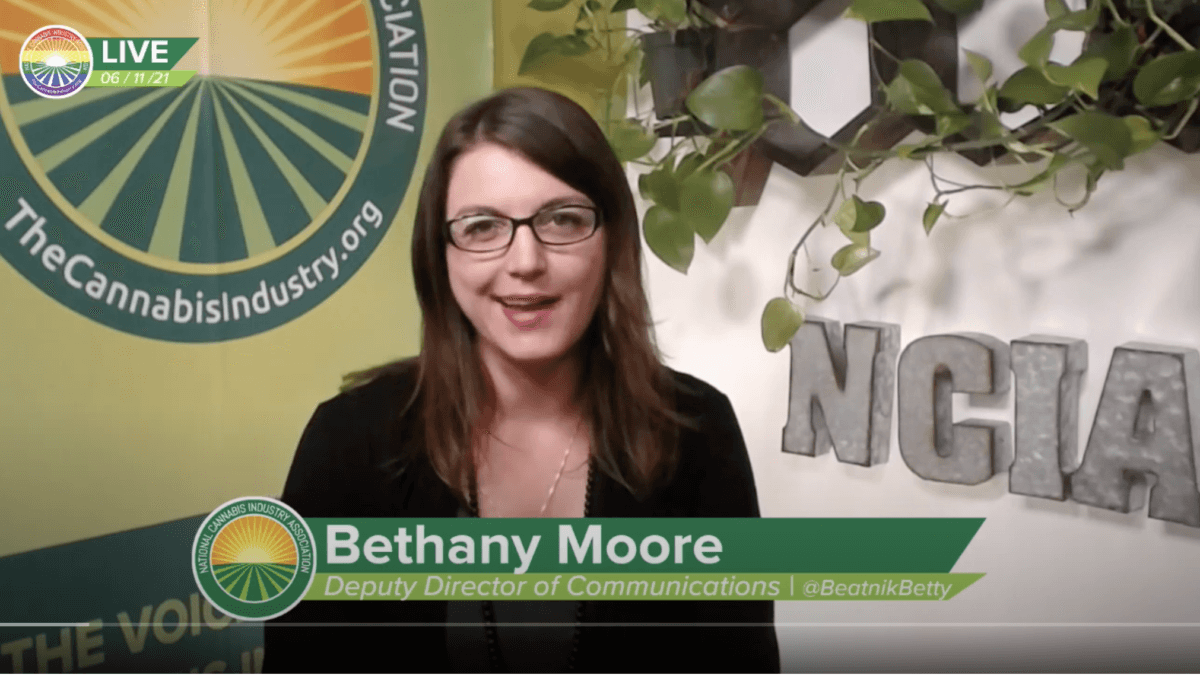


 by Beau Whitney, NCIA’s Chief Economist
by Beau Whitney, NCIA’s Chief Economist
Supply tightness in the labor market represents a significant risk to cannabis operators heading into the summer months. With the potential of wage inflation adding to the costs of businesses, many operators that are struggling to make ends meet due to the economic stresses associated with 280E now face higher labor costs. This labor tightness and higher costs could not have come at the worst time.
The recent U.S. Bureau and Labor Statistics jobs report for May, published on Friday, June 4, 2021, indicated that there were 559,000 jobs added in the U.S. economy. This amount was lower than what analysts had predicted, but still strong nonetheless.
The report also showed that the labor force participation rates held steady which is a good sign that people are not getting too frustrated with their job search. The BLS data also indicated that there are still 9.3 million workers unemployed. Even with these higher numbers of displaced workers, this level is roughly 3.6 million workers higher than it was pre-pandemic when unemployment was at record lows. Considering that 1.1 million workers are on temporary layoff status, a remaining 2.5 million delta is a significant improvement relative to the 18.0 million workers displaced in April of 2020.
While there are differing opinions on policy on how to support the unemployed, the key point here is that the labor force is significantly tighter than what most believe and this could become a major issue for the cannabis industry.
Ever since the great recession, there have basically been more workers than jobs. As a result, employers could pick and choose who to hire and offer them lower wages. This recent job report indicates that now there are more jobs than workers, so workers now have the upper hand when it comes to supplying their labor. This is resulting in wage inflation and labor shortages.
This should be a concern for cannabis operators. Labor is one of the highest costs for operators and if wages continue to rise, this will put a squeeze on already slim margins. Reduced labor availability is already being felt across the country and could become very acute as more labor is required to handle increased retail sales and as the outdoor cultivation industry heads into harvest season. Product manufacturers and retailers are already seeing spot shortages even in states where cannabis operators receive living wages such as in Oregon and Colorado.
In reaction to these labor shortages, some MSOs are offering incentives and sign-on bonuses in order to attract workers, even for positions not requiring highly skilled workers. Unfortunately, smaller businesses may not be able to afford these types of incentives. As a result, this will continue to create competitive advantages for MSOs and to generate opportunities that favor larger firms over smaller ones.
Higher costs are not the only concern for cannabis operators. The heavy burden associated with paying higher federal business taxes due to 280E is already driving smaller operators out of the market or forcing them into consolidation with larger, well-financed firms. Smaller entities already have higher costs. The additional risks associated with labor shortages and higher wages could force more operators who are on the edge, into consolidation as well.
Operators who cannot absorb the higher costs for labor, may need to find additional areas in which to cut costs. Unfortunately, this may involve doing more with less (fewer workers), bringing in automation, or reducing product offerings (lower inventory overhead). A common area of cost-cutting is also healthcare, but in an environment of high competition for a limited labor pool, reducing benefits may not be an option.
While many other programs at the federal level have helped struggling businesses outside of the cannabis space, federal tax reform could be a simple, yet elegant solution that would provide widespread relief to struggling cannabis operators and free up cash flow to help offset wage increases.
In the meantime, the anticipated growth in the overall market may decelerate slightly as the industry encounters headwinds as we head into the summer and fall.
NCIA is working with members of Congress to highlight how critically important sound policy is to cannabis operators across the country and how tax reform makes good economic sense. Bringing the voices of cannabis business owners to congress is a very powerful tool in the effort to reform cannabis laws. Now it is up to Congress to act.

by Gary Cohen, Cova Software
Cannabis dispensary owners must bear in mind that this industry operates under strict laws and regulations that set their business apart from conventional retail operations. State governments must balance public health and safety with the business needs of the regulated community, and that requires complete tracking of all marijuana products from seed to sale. Most states have already switched to METRC, the largest traceability system helping dispensaries from coast to coast stay compliant with the law. The goal of METRC is to easily retrace the steps from sale to seed and facilitate transparency in the legal cannabis industry. This post will help you understand better why METRC is required, how it benefits everyone, and how can you navigate the system while using the right technology to stay compliant.
Marijuana Enforcement Tracking Reporting Compliance (METRC) is a cloud-based, state-mandated platform used by 15 states in the U.S. It facilitates real-time tracking and tracing of cannabis plants and products from seed to sale. METRC was first adopted by Colorado and early reports in 2014 indicated that this regulatory monitoring technology allowed for accurate quality control and ensured that the safety of the end consumer was prioritized.
In all METRC states, cannabis stores and dispensaries must use the system either directly or integrate it with their POS. All data about your dispensary is safely stored in the cloud and is only accessible by you or the state regulatory authority. State regulatory authorities use data inconsistencies in METRC to detect any diversions from the mandated regulations and if they find any discrepancies, they could conduct an investigation and impose hefty fines.
To gain access to the METRC system, all employees working at your dispensary must get certified. The process involves training, studying the terminology and workflows, and then taking a 40 questions multiple-choice test. METRC uses RFID tags as unique identifiers to recognize and monitor all transactions, these are not reusable and must be purchased in batches or bulk by dispensaries.
Every dispensary must incorporate its own solution to work with METRC. One can navigate the system manually but it is a risky and time-consuming process, as it involves countless hours of data entry, auditing, and reconciling processes to deal with the errors that inevitably pop up. The most convenient way to implement METRC is to automate as much of the process as possible. Investing in a robust point-of-sale solution that integrates seamlessly with METRC will ensure complete compliance with state regulations.
METRC’s cloud-based software requires only an internet connection and computer or tablet to access and use it, and an advanced POS system can automate the whole process for you. METRC tracks all plants and products with Radio Identification Tags. The plant tag is used to track each plant from its immature phase through to the harvest, while package tags are available for harvest batches or packages of one kind of product. All these activities must be recorded by dispensaries and reported to state regulatory authorities on time.
METRC charges $0.45 per plant tag and $ 0.25 per package tag. The tags can be ordered directly from METRC’s online software system, and are custom-printed for each dispensary. These can not be returned once the printing process has begun, are non-refundable, and cannot be reintroduced into the supply chain. Recreational cannabis plant tags are blue while medical marijuana plant tags are yellow.
METRC is simply a reporting tool – an application that allows you to send data to the state to maintain compliance. In most states, reports about all activities must be submitted to METRC no later than midnight on the day they occurred. A cannabis-specific POS can facilitate reporting to METRC while providing a user-friendly interface. To get the best compliance solutions, look for a POS that offers 2-way integration. This ensures that reports are sent to METRC in real-time, manifest intake is automated, and inventory adjustments are automatically synced with the traceability system.
Manual reporting will require you to log in to your online METRC account at the end of every business day to enter all data from every single transaction and activity that occurred. This is a time-consuming option that can also result in errors, increasing the risk of compliance infractions, fines, or worse, loss of retail license. Automated reporting with a cannabis-specific POS solution will make your life easier as it integrates seamlessly with METRC and automatically sends all your inventory adjustments and sales transactions as they occur in real-time. Also, if there are ever any connectivity issues, all saved data automatically sync once you are back online.
METRC has standard operating procedures in all states, and dispensaries don’t have a choice but to comply with them. But dispensary owners do have the option of selecting the right POS system that can help their employees navigate the METRC system more efficiently. Download your free copy of ‘A Complete Guide to METRC Compliance for Marijuana Dispensaries’ by Cova, to learn in-depth about the different levels of POS integrations with METRC, how to work best with the system, and state-specific METRC differences.
 Gary Cohen is the CEO of Cova Software, the fastest growing technology brand in the cannabis industry. Cohen’s focus has been driving the company’s overall strategy, including its vision, go-to-market plan, and strategic development. Since joining the cannabis industry in 2016 and launching Cova commercially in 4q17, Cohen has led Cova to dominate the enterprise sector for dispensary Point of Sale, while forging client relationships with hundreds of single-store retailers across North America.
Gary Cohen is the CEO of Cova Software, the fastest growing technology brand in the cannabis industry. Cohen’s focus has been driving the company’s overall strategy, including its vision, go-to-market plan, and strategic development. Since joining the cannabis industry in 2016 and launching Cova commercially in 4q17, Cohen has led Cova to dominate the enterprise sector for dispensary Point of Sale, while forging client relationships with hundreds of single-store retailers across North America.
In solutioning the POS platform, Cohen & the Cova team have met with over 1,900 operators and leveraged expert knowledge to provide retailers the support they need to get a license, pass inspection, launch a store, and improve operations. Cohen leads seminars on retail technology, compliance, business operations, and cannabis banking laws at the industry’s largest events, including the NCIA and MJBizCon. As Cova has become the predominate thought leader for cannabis retail tech, Cohen has established himself as a leading voice educating cannabis entrepreneurs as they build their own successful brands.

 by Trevor Morones, Darwin Mallard, Liz Geisleman
by Trevor Morones, Darwin Mallard, Liz Geisleman
NCIA’s Cannabis Manufacturing Committee
Read on for insight and guidance for the vitally important topic of preventing, eliminating, or reducing microbial growth in cannabis edibles and packaging.
It all starts with the HACCP (Hazard Analysis Critical Control Point) Principles. Gather your team to share the five preliminary steps of HACCP and develop a plan (figure 1). This management system was launched by Pillsbury along with NASA and the U.S. Army for food safety in space exploration in the 1960’s. Quality, safety and efficacy is obtainable and sustainable with the HACCP discipline.

The objective is to PREVENT packaging from being a failure point and inhibit microbial growth in edible products. We know moisture (water activity), temperature, pH, and oxygen levels are primary microbial growth drivers.
HACCP is an asset, not an expense. Food is medicine for some, and cannabis products are medicine for many. Resin cannabis products (RCP) must be safe, consistent, and reliable products continuously. To generate those results, learn the HACCP mindset. Practice being an advocate with HACCP discipline displaying the actions written in the programs. It’s a system for cannabis safety that encourages operations to have Emergency and Business Continuity plans before disruptive events occur, e.g., natural disasters, pandemics, etc.
Creating such a plan is important because exposure to microbes may result in allergic symptoms such as sneezing, coughing, wheezing, nasal congestion, and watery or itchy eyes. Consumers using cannabis products as medicine, such as cancer patients on chemotherapy, are even more susceptible to harm caused by microbes. Thus, it is critical to ensure your products do not have microbial growth.
This is not only a health concern, but the financial impacts can be detrimental. How much did the February 2021 Canadian infused gummy recall cost? More than 330,000 packages of THC infused gummies, worth approximately 8.2 million Canadian dollars, were lost. Overhead costs go above and beyond. The global cannabis industry must learn from industry events such as this.
Effective HACCP management system ensures control. Empower your team through education and training on discipline of HACCP. Take the infused gummy recall from February 2021 as an example where cross-contamination, improper employee hygiene, and package permeability were failure points that led to loss of control. Lack of control during transport of the initially sterile packaging also contributes to contamination. Personal clothing worn by team members or visitors are also known sources of pathogenic fungus.
Best practice is to address preventive controls and reducing/mitigating risks. For example, consider installing two-way humidistatic control devices in packaging, such as desiccant packs, to maintain water activity (Aw) in acceptable ranges to mitigate microbial growth. Reducing moisture prevents powdery mildew caused by Golovinomyces Cichoracearum (figure 2).
A great resource to mitigate risks can be found in the ASTM D37; Standard Guide for Cleaning and Disinfection at a Cannabis Cultivation Center; Aw ASTM Standards for Cannabis Flower: D8196 – Standard Practice for Determining Water Activity in Cannabis Flower; and D8197 – Standard Specification for Maintaining Acceptable Water Activity Range for Dry Cannabis Flower.
Sanitary environments are critical from seed to sale.

Use the principles of HACCP to guide and maintain the integrity of your work. Each principle builds on the next to create a solid foundation to build and operate a safe and consistent management system. Establish storage conditions in your control and transport; determine the temperature and humidity for each product type (gummies do not tolerate heat, and certain ingredients are sensitive to humidity which could change the potency). This includes evaluating the stability of each of the ingredients when in final product form (how long do they remain potent).
Depending on the ingredients used, i.e., the formulation, gummies can take on or reject water. Most typically let out the water, then that water has nowhere to go (trapped in the packaging), and the product molds. This is why commercially produced gummies are coated in wax, literally to trap the water inside the product. Inadequate gummy formulations lead to water permeability; change in cannabinoid content is the least of the concerns.
General chapter 659 on Packaging and Storage requirements published by the USP (United States Pharmacopeia and the National Formulary, USP–NF) is a great resource. Though not all cannabis products may be for the medical market, using the standards of excellence from the USP is the best way to minimize product failure and help ensure consumer safety. Packaging 659 states that packaging materials must not interact physically or chemically with a packaged article in a manner that causes its safety, identity, strength, quality, or purity to fail to conform to established requirements.
Empower your cross-functional team to apply and implement HACCP through your organization. In doing so, you will have the discipline and tools to mitigate risks and prevent costly downtime. Your consumers benefit by having safer, consistent, and quality products. Finally, collect the data and share the story. We all need to drive improvement and produce safe consistent products for our consumers. HACCP systems are a tried-and-true tool to achieve this.
Please note that prerequisite programs such as current Good Manufacturing Practices (cGMPs) are an essential foundation for the development and implementation of successful HACCP plans. This article is intended to level up your current manufacturing processes and mitigate your exposure to potential recall or unsafe products in the marketplace.
For resources on how to establish an effective HACCP system and other quality management related tools, consider adopting the best practices defined in ASTM D8250 – Standard Practice for Applying a Hazard Analysis Critical Control Points (HACCP) System for Cannabis Consumable Products and/or following the guidelines provided in ASTM D8222 – Standard Guide for Establishing a Quality Management System (QMS) for Consumer Use Cannabis/Hemp Products and ASTM D8229 Standard Guide for Corrective Action and Preventive Action (CAPA) for the Cannabis Industry.


By Dr. Dominick Monaco, CLS Holdings
The state of Nevada has always been a unique place to do business. Not only is its economy fueled almost entirely by tourism, but its population is located almost exclusively within a few key urban centers. These factors influence nearly every type of business opportunity in Nevada – including cannabis.
While Nevada’s economic and geographic constraints are unique in themselves, the type of tourist industry found here is one of a kind. Las Vegas is famously known as “Sin City.” It is a place where people flock from around the globe to indulge their vices, such as gambling and clubbing.
As a microcosm of Nevada itself, the Nevada cannabis industry has its own set of challenges and opportunities.
Nevada boasts both medical and adult-use cannabis markets. The state voted to legalize medical cannabis back in 2000, although their first medical dispensary did not open until 2015. While the medical cannabis space in Nevada began with a crawl, the adult-use industry has been quite different.
Nevada voted to legalize adult-use cannabis in late 2016, with the first adult-use dispensary opening mid-2017. Nevada has both medical and recreational dispensaries, although certain stores service both customer bases.
One of the more exciting facets of the Nevada cannabis market has to do with home cultivation. Its unique program allows people 21+ years old to grow at home if they live more than 25 miles from a dispensary. Nevada put these rules in place to accommodate citizens living in rural areas who cannot access dispensaries.
Since Nevada’s legalization, cannabis has become a big business. Here are some statistics for the 2019-2020 fiscal year in the Nevada cannabis industry:
Nevada sales are ahead of other new adult-use recreational markets such as Illinois and Massachusetts to put these numbers in perspective. Nevada falls short compared to more established industries such as Colorado and Washington, but it holds promise for massive growth.
The tourism industry in Las Vegas makes for a unique market. Adult-use market regulations coupled with the global renown of the city lead to an environment where out-of-state visitors greatly influence cannabis sales.
The structure of a cannabis market directly influences business opportunities. In medical cannabis, qualifying conditions and patient counts dictate potential market growth. Conversely, adult-use markets are only limited by people’s age.
The interesting thing about the Las Vegas market is that anyone over 21-years can legally purchase cannabis – this includes out-of-state visitors. According to the Las Vegas Conventions and Visitors Authority website, the city saw 42,523,700 visitors in 2019 alone. These people spent over $10 billion in Las Vegas that year. Within these billions of dollars in tourist money lies an excellent opportunity for adult-use operators in Nevada.
Another fact worth noting is that people flock to “Sin City” to partake in activities inaccessible in other U.S. states. Cannabis fits nicely into this package of taboo activities that can only be done in Las Vegas, NV.
While the tourist money in Las Vegas makes for a very intriguing adult-use market, it is not easy to acquire a cannabis business license. Unfortunately, Nevada has put a cap on the number of licenses available in the state, making it much more difficult to enter than other adult-use states like Colorado.
There are five types of business licenses in the Nevada cannabis industry:
It’s worth noting that both the medical and adult-use markets offer these same business licenses. Similarly, the licensing cap in the state includes both verticals.
As of early 2021, the state of Nevada awarded 132 dispensary licenses. However, these licenses did not go to 132 different operators. Certain businesses acquired multiple licenses, with some able to open as many as seven retail stores. While Nevada has issued 132 retail licenses, there are only 80 dispensaries operational at this point.
The licensing situation in Nevada is frustrating for local investors and outside interests alike. Namely, because studies show that the Nevada economy could support as many as 1,283 more dispensaries than it has issued licenses for. Aggravation mounts with a lack of expansion opportunities in the area.
The state of Nevada only accepts additional cannabis business license requests during “application periods.” These short windows are scheduled by the Nevada Cannabis Compliance Board and stay open for just ten days. However, there has not been an application opportunity since 2018, and it doesn’t appear there will be one anytime soon. As such, it appears that plant-touching opportunities in Nevada are limited to current license holders.
While many believe there is ample room for new players in the Nevada cannabis market, the state does not agree at this point. As a result, if you are looking to get involved in the Nevada industry, you are well-advised to look into ancillary business models instead of plant-touching businesses.
With such promise in the Nevada market, you can rest assured that those cannabis companies that have won licenses will be extremely busy. Ancillary operators can take advantage of this climate by developing models that operate in the business-to-business (B2B) vertical. To help plant-touching companies in Nevada, both product-based and service-based ancillary businesses could prove profitable. Examples of product-based companies include business management software and cultivation technology, while service-based businesses work in marketing, staffing, and consulting.
Opening an ancillary cannabis company in Nevada gives you the ability to enter the market by circumventing the licensing process. Even more, you don’t have to worry about application fees, compliance mandates, and other stressors faced by plant-touching companies. You also have the option to operate across state and national borders if you so desire.
There is no doubt that the Nevada cannabis industry is one-of-a-kind. While there is a good deal of excitement surrounding the market, many feel it hasn’t even come close to reaching its potential. To this end, the adult-use market in Nevada was only 1.5 years old when the COVID-19 pandemic struck. The financial blow of the pandemic was cataclysmic in Las Vegas, as the tourism industry dropped to 50% below average in 2020.
With the pandemic on the downswing in 2021, there is an unmistakable air of excitement across the globe. Some economists feel that we are about to enter a new “roaring 20’s” period, where people celebrate by spending travel money that was unusable during COVID-19. With this celebratory outlook on the near feature, there is no doubt Sin City will see its share of visitors. With the casinos and hotels full again, maybe we will finally see what the Nevada cannabis market can really do.
 Dr. Monaco is the Director of Laboratory Operations for CLS Holdings’ newly opened approximately $4 million laboratory, and is responsible for all day-to-day operations inside the North Las Vegas facility. Dr. Monaco brings over 8 years of licensed & regulated cannabis experience, starting back in 2012 when medical marijuana first opened in Arizona, he has held numerous positions, with escalating responsibilities year over year. He graduated from the University of Arizona College of Pharmacy, in Tucson, Arizona, with a Doctor of Pharmacy in 2010.
Dr. Monaco is the Director of Laboratory Operations for CLS Holdings’ newly opened approximately $4 million laboratory, and is responsible for all day-to-day operations inside the North Las Vegas facility. Dr. Monaco brings over 8 years of licensed & regulated cannabis experience, starting back in 2012 when medical marijuana first opened in Arizona, he has held numerous positions, with escalating responsibilities year over year. He graduated from the University of Arizona College of Pharmacy, in Tucson, Arizona, with a Doctor of Pharmacy in 2010.
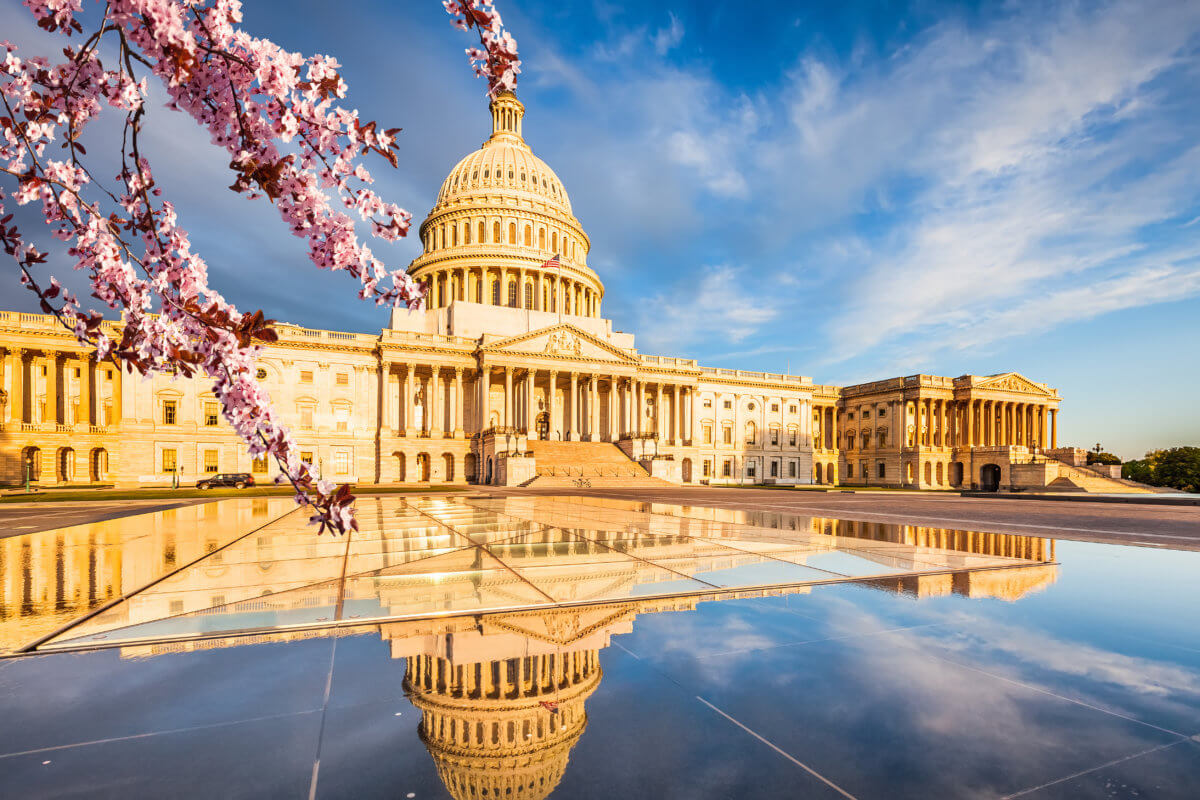

by Michelle Rutter Friberg, NCIA’s Deputy Director of Government Relations
Last week, a long-awaited and much-anticipated piece of cannabis legislation was finally unveiled. On Friday, H.R. 3617, known as the Marijuana Opportunity, Reinvestment, and Expungement Act, or the MORE Act, was reintroduced by House Judiciary Committee Chairman Jerry Nadler (D-NY). You’ll remember that back in December 2020, the House of Representatives made history when they passed the MORE Act by a vote of 228-164. Let’s take a look at the bill and break it down:
H.R. 3617, the Marijuana Opportunity, Reinvestment, and Expungement (MORE) Act
House Judiciary Committee Chairman Jerry Nadler (D-NY) is the lead sponsor, along with Reps. Lee (D-CA), Blumenauer (D-OR), Jackson Lee (D-TX), Jeffries (D-NY), and Velazquez (D-NY).
Just like the last session, the bill has been referred to a number of committees: In addition to Judiciary, it was also passed on to the Committees on Energy and Commerce, Agriculture, Education and Labor, Ways and Means, Small Business, Natural Resources, Oversight and Reform, and Transportation and Infrastructure.
The MORE Act would remove cannabis from the federal Controlled Substances Act and attempt to undo the damage caused by racially and economically disproportionate enforcement of prohibition. It would also eliminate the conflict between federal law and states with regulated cannabis systems, and would require the expungement of past federal cannabis convictions. The bill would establish a Cannabis Justice Office to administer a program to reinvest resources in the communities that have been most heavily impacted by prohibition, funded by a graduated tax on state-legal cannabis commerce. It would also prevent discrimination based on cannabis consumption during immigration proceedings, and permit doctors within the Veterans Affairs system to recommend medical cannabis to patients in accordance with applicable state laws.
As I mentioned previously, during the 116th Congress, the MORE Act passed the House but was not taken up by the Senate. Now, during the 117th Congress, the calculus has changed a bit – on both the House and Senate sides. On the House side, the chamber is more Republican than the last time the bill was passed – meaning that advocates will have to work hard to ensure no more votes are lost and that support increases. On the Senate side, Democrats now maintain the majority by the skin of their teeth, but all legislation effectively needs 60 votes to pass – a difficult threshold. It’s also important to note that the MORE Act has not been introduced in the upper chamber as all eyes focus on Leader Schumer (D-NY) and Sens. Booker (D-NJ) and Wyden’s (D-OR) upcoming comprehensive bill.
When the MORE Act passed out of the House back in December 2020, it contained a small but impactful section that was included at the last minute. This contentious provision related to discrimination against victims of cannabis prohibition in the permitting process. A section that pertained to applications for a federal cannabis permit stated that an application may be rejected and a permit denied if the Secretary of Treasury finds that the legal person (including in the case of a corporation, any officer, director, or principal shareholder) is “by reason of previous or current legal proceedings involving a felony violation of any other provision of Federal or State criminal law relating to cannabis or cannabis products, not likely to maintain operations in compliance with this chapter,” which would be a major blow to the intent of the legislation to undo the harms caused by prohibition. NCIA brought this provision and our concerns to the bill sponsors’ attention, resulting in them publicly committing on the House Floor to revisit and improve this section. That language was not included in the 117th Congress’ recently reintroduced version.
Also of note, the MORE Act includes tax language. When the bill was first introduced in 2019, it contained a tax section that set up a flat 5% sales tax on cannabis products at the federal level. That was later amended to be a graduated tax, beginning at 5% and increasing up to 8% in subsequent years post-legalization. The soon-to-be-reintroduced MORE Act has the same graduated tax levels.
The bill has a long path ahead: as I pointed out, there are multiple committees of jurisdiction that will want to weigh in on this important legislation – I’d venture to say that both the Ways and Means (tax writing) and the Energy and Commerce Committees will have substantive edits. Another consideration is one I’ve mentioned in passing, and that’s the impending introduction of new, comprehensive cannabis reform legislation that will (hopefully) soon be unveiled in the Senate. It’s also important to note that the MORE Act is missing one critical thing: regulations, and we at NCIA believe that those can make all the difference when looking at what’s next for this legislation.
We applaud Chairman Nadler and the other cosponsors of this legislation for tackling this topic, and congratulate them on the bill’s reintroduction! We look forward to continuing to work with their offices to improve and build support for this critical piece of legislation. Stay tuned on our blog, our NCIA weekly newsletter, and NCIA Connect to find out the latest on MORE!
In this edition of our Service Solutions series originally aired on Wednesday, May 19th a dynamic panel of energy experts led by the team at APPI Energy hosted in-depth session on building out an integrated infrastructure to yield a healthier environment for growth. Let the experts walk you through what it means to have a holistic approach to energy management; a strategy that focuses on all aspects of your facility, from securing favorable electricity and natural gas supply contracts, to implementing renewable energy solutions while reducing costs, to exploring the wide array of funding options available to you. You’ll leave this webinar with insights into the energy markets, as well as proven, technology-agnostic solutions for cannabis businesses.
Presentation Slide Deck: https://bit.ly/3vhICtX
Learning Objectives:
• Exploring specific, cannabis-centric energy solutions to help you meet your sustainability goals while reducing costs, including but not limited to: renewable energy, energy storage, and combined heat and power.
• Reviewing options for secure funding for energy solution technologies and on-going projects
• Effective ways to formulate future energy profiles to ensure you have the best pricing and strategy in place
• Available solutions for reaching 100% renewable energy goals
Panelists:
Dan Forgacs
VP of Market Intelligence & Analytics
APPI Energy
Oliver Hoad
EMP – Energy Consultant
APPI Energy
Chris Fraga
Founder & CEO
Alternative Energy Development Group
Ben Samways
Executive VP
Energy Efficiency
Alternative Energy Development Group
Margo Madden (Moderator)
Vice President
Energy Solutions
APPI Energy
Speaker Details & Bios: https://bit.ly/3u37eFk

 by Rachel Kurtz-McAlaine, NCIA Deputy Director of Public Policy
by Rachel Kurtz-McAlaine, NCIA Deputy Director of Public Policy
A Seattle Hempfest lawsuit against the Washington State Liquor and Cannabis Board asks this question.
The title for this piece was inspired by the late Steve Fox, one of the founders of the National Cannabis Industry Association and co-author of the book, “Marijuana Is Safer: So Why Are We Driving People to Drink?” Written in 2009, it questioned why we were punishing adults for choosing a safer alternative to alcohol by criminalizing cannabis use while alcohol was legal. But it remains relevant when considering the laws and regulations under which each respective industry operates.
Last week I wrote about SMS text messaging and the challenges the cannabis industry is currently facing. The industry turns to SMS (text messaging) to a large extent for marketing purposes, often connected with loyalty programs. SMS is a great way to reach someone who specifically asked to receive the marketing and has already been vetted at the store to be over 21, which is huge in an industry with so many restrictions around marketing, advertising, and branding.
But a lawsuit currently under appeal at the Washington State Court of Appeals (having been passed down by the Wash. Supreme Court) is questioning some of these restrictions, especially when compared to the dearth of alcohol marketing restrictions. Seattle Events, who produces Seattle Hempfest, and a couple of legally licensed Washington cannabis companies brought the lawsuit against the Washington State Liquor and Cannabis Board (WSLCB) challenging some statutes and regulations that unfairly harm the industry and Hempfest by imposing restrictions around marketing, advertising, and branding that are not based on any meaningful data and are far more severe than restrictions around alcohol marketing. The differences are pretty stark when comparing the marketing rules and regulations on alcohol RCW 66.08.060 and WAC 314-52-070 with those on cannabis RCW 69.50.369 and WAC 314-55-155.
In Appellant’s Opening Brief, Hempfest and the other appellants offer convincing arguments on First Amendment grounds and broader free speech protections under the Washington state constitution for why some regulations are over-restrictive, but they also make very clear they agree that the prevention of use by youth is a valid state interest. In general, the cannabis industry is interested in keeping cannabis away from minors except for medical purposes – it’s one of the reasons we promote a safe, legal, regulated market. (To fully understand the legal arguments in this appeal, read the WSLCB, et. al/Respondents’ Brief here, and Hempfest, et al./Appellants’ Reply to the Response here.)
As more and more states legalize cannabis for medical and adult-use, and descheduling is contemplated at the federal level, lawmakers and regulators are working with the cannabis industry to craft rules and regulations around such things as marketing. State policymakers are connecting with each other to see where they can make their regulations more uniform, and federal policymakers are considering to what extent they’ll regulate marketing at the federal level on top of what the states do individually.
While these conversations are happening, it’s important to keep in mind the real-world effects these regulations have on the cannabis industry and if they’re unnecessarily more restrictive than the alcohol industry. That’s not to say the cannabis industry wants to look like the alcohol industry, being sold next to toys at Target, or mixing intoxication with driving by sponsoring NASCAR, but sometimes the industry is accused of purposely marketing towards kids for things like infused gummy candies when adults regularly use gummies to take vitamins.
The industry needs to take control of the narrative around youth prevention, working with agencies around rational messaging and regulations. The alcohol industry has a close relationship with the state and federal agencies that regulate it. In fact, a large part of marketing restrictions are self-regulatory standards, aimed to discourage underage drinking, that are entirely voluntary. The more we as an industry can voluntarily create marketing standards, the less likely harsher regulations will need to be implemented. Cronos, an NCIA Evergreen member and a leader in the international cannabis market, recently released its own standards limiting marketing to youth, and NCIA committees frequently release standards that are best practices for the industry.
The cannabis industry is incredibly creative, and thinking outside the box toward what appeals to adults without marketing to kids can be rewarding. The NCIA Marketing and Advertising Committee recently held a contest for best marketing around the 4/20 holiday. You can check out the webinar showcasing the best of that contest for examples on how creative we can be.
The cannabis industry wants to be a shining example of what a responsible industry can look like, that includes how advertising, marketing, and branding might interact with youth. But it is important to use real data for what actually works, come up with voluntary standards, and not put unnecessary restraints on an industry that is under enough restraint.
(If you’re interested in contributing to an Amicus Brief in support of Seattle Hempfest’s lawsuit, please contact Rachel.)

By Carlos Perea, Co-founder and CEO of Terra Vera
One of the direst, yet infrequently discussed, issues in the cannabis industry is the lack of federal guidelines regulating pesticide use. Despite the adult-use cannabis market consistently expanding on a state-by-state basis, as long as the crop remains illegal on the federal level, much-needed national oversight will continue to be limited.
The more states that legalize under a national prohibition, the more varying and convoluted state-by-state crop management regulations may become. Meanwhile, without standards firmly set in stone across the country, some cultivators have turned to hazardous chemicals to control pathogens and preserve their crop yields. Such cultivation solutions can compromise the safety of staff, the environment and, of course, the consumers.
Even when shopping at a licensed adult-use or medical dispensary, consumers today still cannot be 100 percent confident that the cannabis they are purchasing is completely safe and free of contaminants and unwanted components, such as pesticides, harmful microbials, heavy metals, and solvents. Emerging research from Colorado State University shows that contaminants in cannabis, including pesticides, “are imminent threats that directly impact public health and wellness, particularly to the immunocompromised and pediatric patients who take cannabis products as a treatment for numerous human disorders including cancer patients and those suffering from epileptic seizures.” With many consumers turning to cannabis for its health benefits, and because it’s a natural alternative to heavily processed pharmaceuticals, the cultivation process should honor cannabis’ medical use by being as safe and accountable as possible.
The pesticide issue is compounded when we think about how cannabis is often consumed: through inhalation. Additional research has shown that nearly 70 percent of the pesticides used in cultivation remain in the cannabis flower that consumers smoke.
Even when these same pesticides are permitted in other types of American agricultural industries, this is a global anomaly. More than 25 percent of pesticides used in the U.S. are banned in other countries.
So how do we work towards a pesticide-free cannabis industry? Licensed businesses, regulators, and consumers need to band together to set standards and guidelines for pesticide use across each legal state, and eventually on a federal level.
In 2020, Arizona took a page out of Oregon’s playbook by establishing a regulatory agency and adopting Oregon’s standards for limiting pesticide use in cannabis, setting a prime example for inter-state collaboration and accountability. Measures also need to be taken to lower the cost of testing cannabis products for pesticides and contaminants. And, of course, we need to embrace more sustainability and environmentally-minded education, and emerging technologies.
While testing does not necessarily prevent contaminants during the grow process, frequent, reliable, and standardized testing can help ensure contaminated products don’t make it to market. Unfortunately, testing requirements continue to differ by state, with some being more lenient than others. For instance, certain states only test for certain types of microbials, while others allow companies and cultivators to cherry-pick samples. This makes it easier for companies’ products to meet compliance, however, doesn’t ensure that the final products available for purchase will be safe for the consumer. Looking ahead towards inevitable federal legalization, testing requirements need to be uniform across all legal markets.
However, cultivators shouldn’t wait for federal oversight to hold themselves to the highest possible standards. There are inexpensive testing procedures currently available that cultivators can adopt before sending their cannabis products to the lab, which can help to better ensure what they are doing is working and catch a problem before it starts.
There are also non-toxic crop management technologies available now, and in addition to seeking out vendors offering innovation-driven solutions to replace conventional pesticides, cannabis companies and their cultivators can embrace simple, preventative measures to minimize outbreaks of bio-contaminants. This includes controlling humidity at the grow site, plant spacing, adequate air circulation, and implementing a strict chain of custody throughout the supply chain. Successful prevention mitigates the temptation to turn to potentially toxic pesticides to eradicate contaminants.
While federal legalization looms, it likely won’t happen this year. Therefore, state regulatory agencies should continue to be prepared with comprehensive outreach plans to communicate their pesticide and testing regulations to cultivators and their companies, ensuring that industry participants are fully informed. Planning and communication also sets the stage for the industry to have tried and true standards already in place by the time federal legalization does come to fruition.
The good news is the cannabis industry has the potential to lead a paradigm shift towards a safer agricultural sector as a whole. In years past, the amount of information shared between cannabis and other agricultural industries was limited, cutting cannabis cultivators off from reliable best practices for cultivation and crop management. However, this is changing quickly. Cannabis is also pushing the envelope towards more sustainable practices, with more cultivation sites moving indoors and into greenhouses, complete with LED lighting and additional sustainable practices. Cannabis cultivators are becoming more cutting-edge and setting an example for the broader agricultural community. The industry should continue these forward-thinking approaches by embracing pesticide-free solutions on a broad, scalable level.
 Carlos Perea is the CEO and Co-founder of Terra Vera, an agricultural technology company offering innovative solutions to replace conventional pesticides and increase product safety and consumer confidence within the agriculture industry. Carlos is a serial entrepreneur with a focus on the intersection of technology and social impact. Prior to founding Terra Vera, he formed MIOX Corporation, a technology company that treats water in a variety of applications and is distributed in over 30 countries. He is active as an advisor and board member with several early stage companies and social enterprises including YPO, where is he an active board member. Carlos has an MBA from the Stanford Graduate School of Business, and an BS in Mechanical Engineering from the University of New Mexico.
Carlos Perea is the CEO and Co-founder of Terra Vera, an agricultural technology company offering innovative solutions to replace conventional pesticides and increase product safety and consumer confidence within the agriculture industry. Carlos is a serial entrepreneur with a focus on the intersection of technology and social impact. Prior to founding Terra Vera, he formed MIOX Corporation, a technology company that treats water in a variety of applications and is distributed in over 30 countries. He is active as an advisor and board member with several early stage companies and social enterprises including YPO, where is he an active board member. Carlos has an MBA from the Stanford Graduate School of Business, and an BS in Mechanical Engineering from the University of New Mexico.


In this edition of our Committee Insights series originally aired on Wednesday, May 12, 2021 members of NCIA’s Banking & Financial Services Committee convened a panel of cannabis financial experts to explore the current landscape surrounding cannabis capital, how we got here, as well as how best to prepare for future trends. Panelists discussed what new investors will look for, and what to do in preparation for a capital raise both in financial and behavioral terms.
Attendees will walk away with these key takeaways:
• Understand how to make small changes in current practices which will allow you to find the capital they seek
• Sources of capital and which is right for your stage of business
• Understanding of investor match and cues to the right actions sources of funding for your business.
Panelists:
Deborah Johnson, Director of Business Development, MCA Accounting Solutions
Cliff Whatmore, President, MAB Investments, SFO
Sumit Metha, CEO, MAZAKALI
Curtis Winar, Director, Strategic Services, Cannabis Industry Practice Leader – Frost, PLLC
Peter Su, Vice President-Private Banking/Cannabis Banking Team Leader, Dime Bank

 By Rachel Kurtz-McAlaine, NCIA’s Deputy Director of Public Policy
By Rachel Kurtz-McAlaine, NCIA’s Deputy Director of Public Policy
Has your text messaging (SMS) service had interruptions? Are you worried about more interruptions?
We forget how much we rely on text messages when we order things. Text messages keep us updated at every step so we know when things are ready for pick up or are there to be delivered. We also appreciate our favorite businesses texting us sales and discounts.
NCIA members have been making us aware of text messaging (SMS) service interruptions, or complete shutdowns, either for marketing or order fulfillment. We’re still gathering information to understand the full extent of the issue and what we can do to assist the industry with making sure we are afforded our rights.
A few SMS platforms, including At&t, Twilio, Avochato, & T-Mobile, have announced they are terminating services for cannabis companies. Twillio’s website makes it clear they don’t want to deal with cannabis-related companies.
“SMS or MMS messages related to cannabis are not allowed in the United States, as federal laws prohibit its sale, even though some states have legalized it. Similarly, messages related to CBD products are not permissible in the United States, as certain states prohibit its sale. Twilio policy is reflective of US carrier rules in this area, and there are no exceptions to this policy.
Twilio defines a cannabis-related message as any message which relates to the marketing or sale of a cannabis product, regardless of whether or not those messages explicitly contain cannabis terms, images, or links to cannabis websites.”
This crackdown has come on the heels of the implementation of 10DLC, new telecommunications regulations intended to address the pervasive problem of spam (not specific to the cannabis industry). Telecommunications companies have used it as an excuse to exclude legally regulated cannabis companies, or at least significantly interfere with their operations.
Unfortunately, Twilio is a huge SMS platform that has been used by some major players in the industry that provide niche technical platforms for such services as delivery, marketing, and loyalty points. Numerous businesses throughout the cannabis industry rely on those platforms to reach their customers and to better facilitate delivery and order pickups.
We know the impact has been widespread, but some companies have been able to find alternatives, either through workarounds or other SMS platforms that are not cracking down as hard. Alternative workarounds can include the service platform having extremely limited templates for what can be sent via text in order to make sure there is no language that can be perceived as relating to cannabis sales or any links that can be followed back to a cannabis website.
Some businesses have found alternative platforms, but those companies may charge more because they are willing to screen every message that gets sent prior to it getting sent out via SMS. Because of the time and labor involved, that option can really only be available for marketing texts and not the automatic texts that come with ordering and pickup or delivery. It is unclear if the big telecommunications companies will eventually shut those down as well.
While we would love for that not to happen and for the issue to work itself out, until we deschedule we know that these issues will continue to surface. Even if you personally have not been affected by the SMS crackdown, it is important to understand what is happening in the industry because it could affect your business next.
We have the ability to come together as an industry to address this issue. We have been working with legal experts to better understand what is happening, and we have the potential to fight this attack on the legal cannabis industry if there is enough interest.
We want to hear from you. Have you had an interruption in service? If so, have you found a workaround? Is the workaround satisfactory or a huge pain for your business? Are you worried about interruptions in your service in the future? Please contact Rachel if you have any information or personal stories to share. We will respect your privacy in these matters.

 by NCIA’s State Regulations Committee
by NCIA’s State Regulations Committee
Contributing authors Jennifer Gallerani, Tim Gunther, Elise Serbaroli, and Erin Fay
The COVID-19 pandemic and subsequent recession powerfully demonstrated that the cannabis industry is providing essential medicine and products to countless Americans, as well as creating jobs and tax revenue. Retail sales of medical and adult-use cannabis in the United States were on pace to eclipse $15 billion by the end of 2020, and if you include ancillary products and services, the industry is estimated to reach $68.4 billion in 2021. The U.S. cannabis industry is experiencing rapid job growth, boasting an estimated 300,000 full-time jobs in 2020. Those numbers are expected to almost double by 2024. Over the next four years, the industry is expected to add nearly 250,000 full-time equivalent positions. By comparison, roughly 271,000 people currently hold beverage manufacturing jobs. These numbers demonstrate with sureness that the U.S. cannabis industry is on a high-growth trajectory, which makes it imperative that the market operate under a practical regulatory framework that benefits both regulators and operators.
Most states that have approved some form of legal cannabis sales (medical and/or adult-use) have also selected a single, mandated technology platform that all operators must use to track and trace their cannabis seeds, plants, and end products. Some iterations of the current track and trace model — which is primarily centralized approach — sets businesses, employees, and regulators up to fail. Of course, it also further limits the competitiveness of the regulated market with the unregulated market, and the ability for policymakers to be confident that cannabis consumers in their states are obtaining taxed, tested, and regulated products.
Local governments are missing out on tax revenue, and businesses (both large and small) are forced to spend unnecessary resources on a system that is fundamentally flawed. The centralized model, contracting with one specific software provider, and mandating operators to use that software provider in order to stay compliant, is wreaking havoc on the entire U.S. cannabis industry and is not sustainable for a federally-legal and global supply chain.
As a team, the National Cannabis Industry Association’s State Regulations Committee’s Technology and Compliance Subcommittee has spoken to regulators, operators, and international technology providers in the interest of presenting a practical track and trace solution to benefit the industry as a whole. This is the first blog in a series that will highlight the issues that cannabis operators and regulators are facing because of the current centralized state-mandated track and trace model. We propose that the U.S. cannabis industry operate under a more practical framework that has a higher probability of success for regulators and cannabis businesses through slight changes and improvements based on proven best practices.
Track and trace systems serialize assets to identify where assets are (track) and to identify where assets have been (trace). Track and trace is not something new. It is the globally acknowledged standard for product movement and reconciliation in both the Pharmaceuticals and Consumer Packaged Goods (CPG) industries. A secure track and trace system combines material security and information security elements to confirm assets are legitimately produced and sourced, following a pre-defined and auditable path.
As the regulated cannabis markets started to take shape and mature in 2012, one of the driving factors that shaped the need for a track and trace system was the 2013 U.S. Department of Justice Cole Memorandum (Cole Memo). The Cole Memo indicated for the first time that the federal government would only intervene in states that failed to prevent criminal involvement in the market, sales to youths, and illegal diversion to other states.
The first four states to legalize adult-use cannabis were Colorado, Oregon, Washington, and Alaska. All four of these states instituted a market-based licensing system to regulate the commercial activity of cannabis sales. The intentions of the newly instituted policies were two-fold: protect consumer health and minimize diversion, both of which align with the core principles of the Cole Memo. To meet these intentions, the states instituted procedures for inventory control and tracking documentation using a state-mandated centralized model, in an effort to create a transparent and controlled system of oversight within the cannabis industry.
As the industry has developed over the years, most states that have approved some form of legal cannabis sales have selected a single mandated technology platform that all operators must use to track and trace their cannabis seeds, plants, and cannabis products. As shown in Figure 1, the majority of legalized states have chosen METRC as their exclusive contractor of track and trace services.
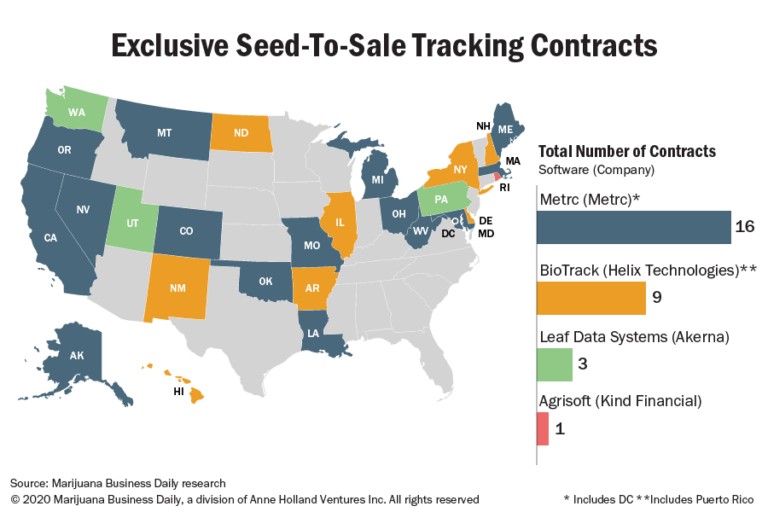
Figure 1: https://mjbizdaily.com/metrc-sees-sale-tracking-opportunities-in-new-cannabis-markets/
The legal cannabis market has changed significantly since 1996 and it is important for the industry to re-evaluate the intention and implementation of track and trace. Regulatory bodies contracting with one track and trace technology provider and mandating operators to use that specific provider in order to stay compliant is problematic for many reasons. Time has shown that the current centralized model is fiscally irresponsible and ultimately counterproductive, with significant negative externalities, including ethical concerns such as anti-trust issues. Most recently, an Oklahoma cannabis operator (seeking class-action status) initiated litigation against the state’s Medical Marijuana Authority (OMMA), alleging that the state exceeded its authority by requiring licensees to pay for a state-mandated track and trace program, and that the state’s contract with METRC creates an unlawful monopoly, among other claims.
To provide an analogy, let’s think about how businesses are required to report taxes. The IRS sets out certain rules and every business must report their income and assets according to that framework. Technology providers (such as TurboTax, Tax Slayer, H&R Block, etc.) have built scalable products to support businesses in reporting their taxes. The IRS does not mandate that businesses use one single specified software in order to report their taxes. Doing so would kill competition, introduce a monopoly, and eliminate any incentive for the technology providers to improve their product. By the IRS allowing free competition over the realm of tax preparation and processing software, the public benefits from the technology companies being incentivized to update and improve their software features and benefits.
The centralized model is crippling the entire industry as system failures are occurring on a more frequent basis, and its after-effects are causing a more detrimental and wide-ranging impact as the industry grows at an exponential rate. Most recently, METRC’s integration functionality (how third-party business operations software communicates to the state’s system) was down for more than fourteen days in California, causing significant problems in the nation’s largest cannabis market. One software provider and its tag-producing partners are benefitting, while setting industry regulators and operators up to fail. One software provider cannot meet the current or future needs of regulators and operators, especially not on a national level. Meanwhile, there are many excellent software providers that specialize in track and trace. The free market should determine the most efficient and user-friendly approach to allow businesses to stay compliant and accurately report to the appropriate regulatory authorities.
By leveraging the knowledge and experience the industry has gained over the last 20 years, we can incorporate best practices from other industries’ and other markets’ track and trace systems, and set regulators and operators up for success.
Join us as we dive deeper into the issues surrounding compliance and track and trace in the cannabis industry. Our multi-part blog series provides an in-depth look into the technical shortcomings of the current centralized approach and provides a roadmap for implementing a distributed model approach. Some of the disadvantages we will cover in the subsequent posts include:
Impact of System Failure: The current centralized model provides a single point of failure: if the system goes down, all licensee operations must stop operating entirely. In some cases, operators may manually record activity during a system failure, and then manually enter the activity when the system resumes. This introduces a high risk of human error. No backup system or alternative means of recording through the use of technology exists since the state relies on only one system.
Challenges with Scalability: The history of performance with centralized track and trace systems demonstrates that there are significant challenges in scalability because of multiple system failures and shutdowns. The system would benefit from a more advanced track and trace capability, specifically with its API (Application Programming Interface). Many times it is not the technology of the licensee system, but the technology design of the state-mandated systems.
Fiscal and Environmental Impacts: Licensees are required to purchase plant and product tags from the single state-mandated vendor, which creates a fixed price system that is typically not in favor of a licensee. It is also creating a sustainability issue in the industry, as the plant and product tags are single-use. More operators are speaking up about the waste it is generating in our cannabis industry.
Interested in joining us in establishing an effective and scalable track and trace framework for regulators and operators in the legal cannabis space? Click here to stay updated on the State Regulations Committee, and the efforts that it’s Technology and Compliance Subcommittee are taking to improve and advance track and trace nationally. Let’s close the informational gap between operators and regulators, and help the entire industry move forward together.
Stay tuned for the next two blog posts in our multi-part series!
#cannabisindustry #legalcannabis #trackandtrace #wearethecannabisindustry #cannabiscompliance

In this edition of our Catalyst Conversations series originally aired on Tuesday, April 6, the NCIA Marketing and Advertising Committee teamed up with the Diversity, Equity, and Inclusion Committee to create a powerful discussion every Social Equity operator should join in on.
Smaller operators spend a lot of money and energy on marketing efforts, but too often it’s wasted on lots of tactics and noise and not enough on strategy and precision. Marketing is one of the least understood, and under-utilized aspects of business that small business owners fail to properly take advantage of. The return on investment is often too little, because they don’t make the right investment and don’t understand how to best leverage the assets created and platforms available as part of a greater strategy.
During this webinar, you will gain a better understanding of the importance of marketing and how to best leverage different marketing strategies (and platforms) to benefit your business, particularly as a Social Equity or Legacy operator. Learn how to bring simple marketing tactics into your overall business strategy, while also getting pragmatic information on what you should look for when vetting marketing firms. Maximize your ROI and know how your money is being spent!
Attendees will walk away with these key insights:
• Understand the importance of Marketing and how best to leverage different marketing strategies and platforms, based on your brand, location, goals, budget and target audience
• Get pragmatic information on what you should look for when vetting Marketing firms
• Learn how to incorporate simple marketing tactics into your overall business strategy
Speakers:
• Amy Larson, VP of Marketing & PR, Simplifya
• Josefine Nowitz, Co-Founder, Cannabis Creative Group
• Kay Villamin, Co-founder & Creative Marketing Director, Hush Chicago
• Devin Jones, Store Manager, Elev8 Eugene

 by NCIA’s Cannabis Manufacturing Committee
by NCIA’s Cannabis Manufacturing CommitteeDespite prohibition, the cannabis industry is not behind the curve of sustainability progress. While other industries were inventing modern Cloud-based quality control/distribution systems and making stuff out of plastic, cannabis producers were maximizing yields per watt and creating stronger concentrates in attempts to get the most out of their value streams while staying under the radar. Now all industries are racing towards a more sustainable future and the cannabis industry has the opportunity to show that it can be a good example, even a leader in sustainability. Regardless if it is in preparation for competition or regulation, now is the time to start building more sustainable, energy-efficient, and overall lower footprint businesses.
As the manufacturing branch of the cannabis industry paves its way into the future, the processes involved need to be made environmentally sustainable and best practices need to be shared and standardized to ensure product safety and industry longevity. Collecting and sharing data from manufacturing facilities is the ideal way to achieve these sector goals.
Environmental sustainability is a multi-discipline effort. Experts in engineering, emissions, air quality, worker health and legal matters should be relied on for educating and guiding businesses into a more sustainable future.
While cultivation is one of the main focuses of the cannabis sustainability effort, manufacturing procedures are also prime targets for sustainable advancements. Due to the nature of the organic chemical processes used to produce consumables, some of the materials and practices could have a negative impact on both worker and environmental health if not addressed and handled properly. As a best management practice, regulated cannabis manufacturers typically operate closed-loop systems, which greatly reduce certain dangers, but this can require other more energy-intensive systems. As these relatively new processing techniques are being pioneered, we need more data to understand how they can be made more efficient and sustainable. For various reasons — such as intellectual property concerns — advancements in sustainable practices are often not shared and therefore not visible to potentially become a standard process that ensures product and consumer safety.
The scientific improvements for manufacturing cannabis into consumer products in high demand have outpaced regulations. From process design and equipment to processing material sourcing, the manufacturing branch of the cannabis industry has much to offer the future of sustainable cannabis products. In many jurisdictions today, regulators have hastily opted for vertical, prescriptive regulations which have left many manufacturing operations without the leeway required to innovate more sustainable process strategies. Even more businesses with the legal leeway simply do not want to push the envelope in today’s regulatory climate. More forward-thinking, regulation-savvy equipment manufacturers have begun focusing on lower energy-use in their newer products as a selling point. The industry as a whole could be making progress much faster if regulators focused on performance standards for manufacturing facilities.
Strategies inspired by building and process heat recovery offer dozens of basic possibilities when it comes to implementation in a cannabis manufacturing facility. Using the energy released during solvent condensation for solvent evaporation is a prime example. Connecting liquid-cooled equipment with the building’s central plant system is another. These are big ideas that could be implemented in different ways with different efficiencies. Intelligent use of insulation, exhaust recirculation, odor mitigation, ventilation minimization, demand-control ventilation for providing makeup air, etc. could also make significant differences. Data collected from actual operating facilities experimenting with different strategies will be the best guide going forward in determining what the best energy saving strategies are.
In an effort to prevent unnecessary Volatile Organic Compounds (VOC) emissions it is important to maintain proper solvent transfer and storage, perform extraction equipment inspections, and ensure a maintained inventory and handling of solvents on site are a part of a facility’s standard operating procedures. Best practice for extraction and post-processing dictates the use of butane, propane, CO2, ethanol, isopropanol, acetone, heptane, and pentane as solvents to encourage safe consumer products.
Carbon filtration is also the best management practice for controlling cannabis terpenes (VOCs) and odor emissions. It is important to install properly engineered molecular filtration systems (aka carbon scrubbers) that are sized appropriately for a facility’s ‘emission load’ and don’t exceed the maximum cfm rating for air circulation through the filter. To prevent VOC and odor breakthrough, it is imperative to inspect and conduct regular maintenance of HVAC systems and carbon filters. A standardized method for measuring the lifespan of carbon is by using a Butane Life Test, which equips manufacturers with the data to know how to manage their carbon replacement schedule effectively, minimizing unnecessary carbon waste. Additionally, processors can conduct air sampling to detect and measure VOC and odor levels in their facilities and the data can be used to validate the impact of control technologies further protecting worker and environmental health.
Proper VOC and cannabis odor control from manufacturing processes helps reduce community odor complaints and improve neighborhood relations. It also improves public and environmental health by reducing local ozone concentrations. Proper emissions control when running cannabis manufacturing processes and handling chemicals helps to shift the industry at large toward sustainable and environmentally conscious business practices.
Cannabis manufacturers are seeing big changes on the horizon. Increased legalization brings increased competition and inevitable M&A activity. Whether a business aspires to compete on the world stage or to be acquired in one of the coming green waves, there are actions that can be taken today to help cannabis manufacturers maximize their value to both customers and potential acquirers.
One of the most important assets a company can have — both to compete effectively and to attract purchasers — is intellectual property. Intellectual property, or IP for short, is the term for an intangible asset that has been afforded certain legal protections to solidify the asset into a commodity that can be bought, sold, and licensed. IP can have a negative connotation in some circles, mostly resulting from misconceptions in the law but also rooted in IP abuses by unscrupulous “trolls.” In reality, IP is an important tool to help companies protect their hard work and, when properly deployed, intellectual property can increase transparency into cannabis manufacturing processes and open new avenues of scientific advancement.
Intellectual property broadly covers a number of different types of rights. Patents protect new inventions like processes, machines, compositions of matter, ornamental designs, and plant genetics. Patents can grant relatively broad rights to these ideas, but with substantial additional costs and scrutiny.
Similarly, copyright can protect creative works, like writings, drawings, and sculptures. But many do not recognize that copyright can also protect compilations of data that have been creatively selected or arranged. Data and algorithm copyrights are relatively nascent, but they promise to play a large role in the intellectual property landscape of the future cannabis industry.
Another sect of intellectual property, trademarks, is all about protecting a brand: the names, logos, slogans, and overall look that tells customers that a good or service is from a particular company. Federal trademark registration is unavailable for federally illegal goods and services, but that does not mean that federal trademark protection is unavailable to cannabis brands. Many companies are using the zone-of-expansion doctrine baked into federal trademark law to set up registrations on related legal products (smoking/vaping devices, clothing, and even CBD edibles) that can be expanded to cover THC products when federally legal.
The nuances and requirements of these property rights — along with other IP rights like trade secrets and trade dress — are highly fact-specific, so involve a good IP attorney to guide your strategy from the start.
Now is the time to start building more sustainable, energy-efficient, and overall lower carbon footprint businesses and the emerging legal cannabis industry is well-positioned to be the leader. If manufacturers are incentivized to safely share processing data directly or through emerging data collection and tracking platforms, the industry will make major advancements towards more environmentally sustainable practices. Environmental impact areas, such as air quality, energy, water, soil waste, and community all need to be considered by the manufacturing arm of the cannabis industry. Regulators can help push the industry forward by reducing negative impacts in these areas though focusing on performance standards for manufacturing facilities and their processes. Lastly, understanding that IP, including trademarks, can in fact increase transparency into cannabis manufacturing processes and open new avenues of scientific advancement will help position operators for M&A activity coupled with proper legal representation. These factors work together to protect the environment and communities, as well as future-proof manufacturing operations setting up the rest of the cannabis industry for longevity and federal legalization.

 By Deborah Johnson, MCA Accounting Solutions & James Whatmore, MAB Investments
By Deborah Johnson, MCA Accounting Solutions & James Whatmore, MAB Investments
NCIA’s Banking & Financial Services Committee
Part 3 of a 3-part series
In our first two blogs we took you from early concept, legal formation and early efforts through the early angel rounds. You have production in place with some equipment financing, getting you to early-stage revenues. Hopefully a smart angel investor is available to you for questions or direction. In the final part of this blog on funding your business, we will present some formal round structures, how you can best prepare for those finance rounds, and some ways to bring your friends along for the ride.
Everything you have done to date is going to be considered in a Series A round. What you have done and who you have surrounded yourself with will be looked at by potential investors. You have put in the work and built strong social capital. You have a diverse and strong team with expertise in your sector. The next level of investor will want to see how you tie it all together. These factors will be considered in light of your Total Addressable Market (TAM), valuation, use of funds, jurisdiction, and many other metrics. At this level a solid accounting team can produce Canna-GAAP (Generally Accepted Accounting Principles) financials to build a credible financial model. Having this current as you move through funding will give investors some level of comfort. As we have discussed, preparation is particularly important.
Alain Bankier, an active Angel investor, points out, “If you have brought on the right group of Angel investors, they are a prime source of excellent feedback, as you prepare your deck, your financials, and your pitch for the next round. Angel investors have seen 100’s if not 1000’s of company pitches and they can help you craft the most compelling presentation and they are your natural allies, as they have already invested and are motivated for you and the company to succeed!”
Long-term planning will help you define the total amount of funding you will need for certain milestones of development. A series of capital raises has some advantages over a single funding event. Each milestone you pass signals a value add to the company, and each subsequent round will be less dilutive. And the investor may see the project as de-risked, increasing their commitment through the follow-on rounds.
For each round there are several types of funding instruments: SAFE agreements, convertible debt, and preferred equity to name a few. Simple Agreement for Future Equity (SAFE) may be an option early in the funding plan. A SAFE note is a convertible security that allows the investor to buy shares at a future priced round. It has no maturity date and no interest rate. As such they are not debt and therefore do not accrue interest. But it also requires C-Corp status as the note goes on the cap table just like stock options. A convertible note is a common way to kick off a formal funding cycle and is dependent on future rounds as a trigger event. As a note it has a term of maturity and an interest rate; often there will be a cap on conversion value and a discount on valuation below that threshold. Once triggered, both of these may convert into shares of the company (or units of an LLC); what those shares are is described in the offering documents, usually summarized in a term sheet outline. These shares can have any number of rights or preferences attached to them. The fact that these are triggered by further rounds makes them a good part of an overall funding strategy.
The alphabet soup of rounds starts after the convertible note. The first equity A round will essentially sell some of the company to your investor; there will be a price, your valuation, and terms. As long as you are executing on the vision you have communicated to investors, each additional round will reflect your progress with a higher valuation and less attractive rights. The business put forth by you and your PowerPoint pals from the first blog in the series was worth a couple thousand dollars. Now you can apply many metrics on your sales, balance sheet, or milestone for a multimillion-dollar value.
Convertible debt and equity rounds are part of your long-term funding plan; so are new target investors. As you hit milestones and rise in valuation, the company becomes attractive to new investor classes. Certain funds have a minimum milestone they need to see before considering an investment. Pre-revenue, post-revenue, cash flow positive, market share, and total sales all have relevant hurdles for certain groups. Seed and angel investors may participate in a convertible note getting you to revenues, while an investment fund will only lead the A round with those revenues in place. If all is right, they will participate in B and C rounds as well; with larger and more sophisticated investors looking at the milestones you are currently achieving. The investors who value your milestone wins will take notice and start to circle.
As the investment in your company grows, the pool of investors shrinks. Although this may change in the near future, the traditional investment landscape is limited in cannabis; fortunately, there are several new and non-traditional sources of funding. Crowdfunding is a trend that has not escaped cannabis; however, the stigma has limited the platforms those in the industry have access to. Crowdfunding via Reg CF is the use of small amounts of capital from a large number of individuals. It is legal to be part of a cannabis business by investing up to $2,000 in exchange for ownership of a portion of the company. Through this method, a company can raise up to $5 million. Sites such as Fundanna, CannaFundr, Start Engine, Kickstarter, Crunchbase, Mazakali, Useed, Indiegogo, and SeedInvest provide platforms to market opportunities. There are various hurdles encountered here as well. Platforms can have banking issues as well. For example, 420fundme was shut down after their bank decided not to work with them. Also, some require the business to be in a U.S. state where cannabis is legal, or they only promote those businesses that impress them. So be sure to understand the sites’ rules and stay on top of regulations.
The REG A(+) is crowdfunding’s big sibling. This is an investment vehicle that is exempt from registration with the SEC that allows the general public and not just accredited investors to join the round up to $50 million in a 12-month period. GAGE, a Michigan vertical, successfully funded their recent expansion with a Reg-A. If you are talking to investment banking firms, this could be a good late-stage option to secure a large round of capital.
As you prepare to fundraise and have a clear understanding of where your business is in its lifecycle, you can put together the best capital raise for your project. Cannabis is a relatively new industry, and its murky legality means that roadblocks are likely. Be prepared to exercise all of your financing options. When raising funds for equity, all of the investors are looking for a liquidity event. So, whether your company eventually goes public or there is a merger or acquisition, they are not looking to invest in a so-called “lifestyle” company. As legality is resolved, many companies that are now on the sidelines looking in will be looking for opportunities to acquire and appear “established”. This is your window of opportunity to build a great brand, gain traction and be ready for when that happens.

Brad Douglass, Ph.D., EAS Consulting Group Independent Consultant
The Agricultural Improvement Act of 2018 (the “2018 Farm Bill”) helped to further define the pathway by which “hemp-derived” ingredients can be legally incorporated into food. Since then, hemp-ingredient companies have materialized selling purified cannabinoids that are found naturally-occurring in hemp. Despite the young market, these companies are facing difficult times as the buyers for these ingredients are few and manufacturers mostly compete on price. The GRAS path offers a route out of this conundrum.
What is GRAS?
The Generally Recognized as Safe (GRAS) for food-use pathway was established by the 1958 Food Additives Amendment to the Federal Food, Drug, and Cosmetic Act (FD&C Act). It delineated how substances that are GRAS for their defined conditions of use in food are different from food additives.
Others have previously delved into why firms might consider pursuing GRAS notifications and/or New Dietary Ingredient Notifications (NDIN) independent of hemp and hemp-derived ingredients so I will refrain from wholesale repetition. Two key points on specificity are nonetheless worth repeating: 1) a substance is deemed GRAS for a specific use under specific conditions and 2) a GRAS notification is specific to the company filing the notification.
Why GRAS?
There are a number of practical reasons why firms that produce cannabinoids would seek to pursue the GRAS pathway. Here are five:
Market Expansion
Currently, firms that produce purified hemp cannabinoids are mostly selling their wares to businesses operating in state-regulated delta-9 tetrahydrocannabinol (THC) markets or to operations that may not be in full-compliance with dietary supplement regulations. Almost all firms that produce food products, including beverages, and most dietary supplement manufacturers, will not use ingredients that do not have a history of use in food or that cannot be legally marketed.
For ingredients such as purified hemp cannabinoids that do not have a history of use as articles used for food, the only way to open-up the food, beverage, and dietary supplement markets is via the GRAS/NDIN pathways.
Safety Demonstration
An integral part of any GRAS dossier is the basic demonstration of acceptable risk (cf. safety) for the named substance and impurities. This includes any byproducts that may be introduced by the manufacturing process. Whether one is interested in pursuing a GRAS Notification for submission to FDA or for a self-affirmed GRAS conclusion, the process involves an evaluation of safety for the conditions of use (e.g. serving size, no-observed adverse event level, etc.).
Beyond the ethical necessity of understanding the hazards of a product meant for human consumption, pursuing GRAS helps protect a firm from product liability in the event that harm is created. But more importantly, GRAS helps guard against product liability by seeking to prevent the potential hazard in the first place. That is always good for business.
Avoiding Drug Preemption
FDA has described in numerous forums, including the Administration’s own website, why it has concluded that cannabidiol (CBD) cannot be used as an ingredient in food or dietary supplements. The key is section 201(ff)(3)(B) of the FD&C Act. This section disqualifies an ingredient from use in food or dietary supplement products if the ingredient is 1) an active ingredient in an approved drug or 2) if substantial clinical investigation of the substance as a drug has been conducted AND made public.
While the situation remains unclear for CBD, the only way to avoid a similar murky situation for other cannabinoids (e.g. cannabigerol, CBG) is for those ingredients to be marketed as a food or dietary supplement prior to the public disclosure of clinical trials directed at the development of that substance as a drug.
It is FDA’s position that “legal” marketing entails more than simple inclusion of the substance in marketed products — the substance must have been the subject of GRAS, food-additive, or NDIN pathways, if required, to be legally marketed. To that point, FDA is highly unlikely to conclude that legal marketing includes the marketing of products in state-regulated cannabis systems while THC remains federally illegal.
Side-Stepping Price Wars
The nascent hemp-derived ingredients market is experiencing significant downward price pressure. The reasons are simple. There is currently more supply than demand (see #1 above) and all commercial offerings are essentially generic.
The GRAS pathway is a mechanism out of this me-too trap. A GRAS cannabinoid would be a premium ingredient by virtue of GRAS status alone. Premium ingredients command premium prices. And the types of sophisticated customers that firms like to do business with do not mind paying premium prices for compliance.
Regulatory Intelligence
While we wait on FDA to draft regulations for manufactured hemp-derived products, it is difficult for businesses to make decisions about what products to pursue. Some firms may not care about internal FDA thinking for hemp-related issues like delta-8 THC or proposed New York State in-process hemp material THC limits of 3%, because they are going to seek to exploit the here-and-now.
For forward-looking firms, engaging with FDA through GRAS or other regulated ingredient pathways can help illuminate what lay around the bend. Effectively navigating bends in a fast-paced, regulated marketplace can be the difference between knowing when to brake… and going broke.
How GRAS?
There are a few ways to go about this, but simply asking the question within your company and with your legal and regulatory counsel will help generate more of a groundswell. There are a few hemp- and cannabinoid-specific intricacies that must be navigated in practice, including FDA’s own policies on hemp. But there is no reason why this cannot be done.
EAS Independent Consultant, Brad Douglass, Ph.D., evaluates FDA and FTC compliance of dietary supplement materials including review and audit of dietary supplement labels and labeling. He is experienced in multiple technical, quality, and formulation roles in the dietary supplement and cannabis industries which lends perspective not only regulatory requirements but also the realities of real-world business. Brad’s previous positions include VP of Regulatory Affairs and Director of Advanced Botanical Strategy at the Werc Shop in Los Angeles. He has a doctorate in Organic/Medicinal Chemistry from USC. EAS Consulting Group, a member of the Certified Group of companies, is a global leader in regulatory solutions for industries regulated by FDA, USDA, and other federal and state agencies. Our network of over 150 independent advisors and consultants enables EAS to provide comprehensive consulting, training and auditing services, ensuring proactive regulatory compliance for food, dietary supplements, pharmaceuticals, medical devices, cosmetics, tobacco, hemp and CBD. easconsultinggroup.com
If you represent a firm that creates hemp-derived cannabinoids, are a regulator that has responsibility over products that incorporate non-THC cannabinoids, or are just an interested reader that has been intrigued by this blog post, do not hesitate to reach out to me at bdouglass@easconsultinggroup.com.

By Mell Green, CBD Oracle
Medical cannabis hasn’t always had a smooth go in the United States. Thankfully, as time has slowly started to change and viewpoints have shifted, cannabis legalization is finally gaining traction state-wide. While this is an incredible feat for so many different reasons, many states see long-term benefits of cannabis legalization much further reaching than anyone could have imagined.
Today, we’re talking about how cannabis legalization in Minnesota may actually help further equality and break down barriers that have long been deeply rooted. Let’s get started.
Quickly, it’s essential to understand the tumultuous history behind marijuana and just how far we’ve come as a society. However, seeing this rocky past also helps illuminate how much further we still have to go.
The cannabis plant has existed for millennia on planet Earth. Its therapeutic benefits have supported civilizations in spiritual, religious, and medicinal ceremonies across the globe. As this idea spread to Western societies, the plant was, at first, welcomed with open arms. At the start of the 20th century, all of this changed entirely in the United States.
During the Mexican Revolution from 1910-1920, many Mexican citizens fled their war-torn home country in search of a safer, more promising future. With this, the U.S. saw an influx of Mexican immigrants.
Throughout Mexico, enjoying cannabis for its recreational effects wasn’t a new idea. So, when citizens began migrating North, they also brought more normalized recreational cannabis use. At first, for those in the U.S. who already adored cannabis, this was incredibly exciting. But, for many in positions of power, class, and wealth, this type of cannabis use wasn’t going to fly. Thus came the Reefer Madness film and decades-long racially charged cannabis persecutions.
It took way too long, but the United States finally started getting on board with cannabis decriminalization and legalization back in the 80s and 90s. With this, the exposure to cannabis science became more extensive, and it was easier to see that the plant did (and still does) have some serious medicinal benefit. Seeing these facts caused a lot of opinions to change, resulting in an almost domino-like effect of cannabis legalization across the country.
Now, 36 states have legalized medical cannabis, allowing more people than ever access to the precious plant they love. But has this legalization impacted the people most disproportionately punished? Not really.
Still today, we see Black men arrested for cannabis crimes at disproportionately high rates, even though cannabis is legal in most states across the U.S. If anything, these legal changes have made the divide all the more evident, allowing the country to see just how horrific the cannabis industry can be for people of color. At the same time, it simultaneously celebrates white American consumers. This may help boost PR for big business, but it doesn’t help local (black-owned or otherwise) businesses on the ground. Legally or economically.
So, what can we do to change this? How can cannabis legalization help to further the progress we’ve made?
I know, it sounds like we’re a bit cynical, but it’s crucial to bring up these divides before discussing how we can move further. The country often loves to praise all the beauty that the cannabis industry brings, forgetting the intense harm it has caused so many communities.
Let’s talk about Minnesota, for example. In May, it looks as though the state is going to vote to pass adult-use cannabis use. If this happens, here’s what could potentially occur in terms of furthering equality — but, at the end of the day, this change is up to you.
Realistically, the legalization of cannabis should help reduce the number of victimless crimes in the area, helping the community feel more at ease. With this, you would also expect a lowered number of consistent police presence in areas where cannabis use was a previous “problem.” Often, when communities of color experience increased and frequent police presence, this does not provide a sense of safety. Typically, it provides the opposite. Thus, legalizing cannabis in places like Minnesota may be able to create an environment that not only feels safer but feels more accepting of all residents. Feeling safe is great for business, big and small – but especially small. Reduction of victimless crimes and less police presence could really boost the state economy, and additionally enhance everyone’s sense of community and unity.
Furthering equality through the legalization of cannabis can be done, but the work goes much deeper than just on a legal level. As we’ve seen, just because the law says one thing, that doesn’t mean it applies to all groups of people. So, once legalization happens in Minnesota — or your state — the next steps are in your hands.
With this, you’ll also understand how legalization is not an end-all-be-all solution. If we want to erase cannabis’s racially charged stigma, the answer is holistic: it starts with a community.
 Mell Green is a content creator who believes that cannabis can help anyone achieve a life-enhancing experience. Her participation in the advocacy of the plant for the last several years has not only allowed her to create solid relationships with the world’s leading cannabis companies, but it has also helped her to educate and spread awareness on the power of alternative medicine.
Mell Green is a content creator who believes that cannabis can help anyone achieve a life-enhancing experience. Her participation in the advocacy of the plant for the last several years has not only allowed her to create solid relationships with the world’s leading cannabis companies, but it has also helped her to educate and spread awareness on the power of alternative medicine.
CBD Oracle is a California-based online magazine dedicated to cannabis and CBD education. The company has made it its mission to provide specialized, expert advice to those who need it, publishing detailed, informative, and entertaining articles, guides, and reviews, all backed by the latest scientific studies and research.

In a year that has tested everyone’s resilience, our industry found new legitimacy as cannabis was deemed “essential” by lawmakers and regulators during the pandemic. As we slowly emerge from a shut down, the members of the Marketing & Advertising Committee (MAC) all agreed that 4/20 celebrations have brought a new meaning in 2021.
We celebrate that we have survived, and grieve for those who have lost so much.
We celebrate that cannabis legalization has moved forward – and rapidly – in several more states.
We celebrate that our industry continues to adapt so well, as it has throughout the last few decades.
Part of that celebration was reflected in clever and innovative 4/20 promotions. Of course, they were executed under CDC and county health guidelines because we know compliance, don’t we? Several NCIA member retailers, brands, and companies rose to the occasion, and we as marketers wanted to recognize that creativity and ingenuity. So, this year NCIA’s MAC committee asked for nominations for the best 420 Marketing Campaigns…and our members did not fail to deliver!
On Tuesday, May 5th, 2021 at 3:00PM EDT, NCIA’S MAC committee will recognize and showcase several of those marketing successes in our #IndustryEssentials Best Of 4/20 Marketing Campaigns celebration webinar. And, in a twist, we’re letting YOU decide who is the best of the best!
We’ve collected dozens of incredible entries and have boiled it down to EIGHT finalists to showcase during the broadcast. Congratulations to our finalists!
NCIA members will vote live to determine the top three. You won’t want to miss this interactive program featuring the best and brightest minds in the marketing space sharing each other’s most successful strategies surrounding the biggest retail day (and year) for our industry.
Here is a quick overview of the finalists (in no particular order):
Rebelle’s 4/20 Series began with a campaign to petition Governor Cuomo in New York to legalize cannabis. CGP ran a series of billboards around New York in high traffic areas and another at the entrance of the Lincoln tunnel. Finally, CGP conspicuously placed a billboard in Albany with the hopes of gaining attention from the Governor. This campaign was done with the help of Verdes, a design agency who has worked with the likes of Nike and Target. The messaging was loud and clear: “Legalize Loud, Legalize New York, Legalize Now”, “New York Wants All The Smoke”, “I (Pot Leaf) NY”. Their team banded together with the creation of personal Instagram accounts that coordinated messages daily, highlighting the inequities and harm done by the prior war on drugs. Billboards were highlighted on news channels in Brooklyn and Albany.
The loud billboards must have worked. Once legalization passed in New York, messaging shifted gears. The next round of ads debuted April 20th on the NASDAQ Billboard in Times Square. This time, it’s a message of celebration: “Happy 420”, “Let’s Get Loud”, “Let’s Rebelle”. After their 420 moment, Rebelle celebrated NY legalization 4/20 it’s first ever Rebelle 420 party at an outdoor restaurant patio location, Ten Hope in Brooklyn.
“4/20 Social” | Golden State Greens
Golden State Greens was back at it again with it’s first in-person event since Covid labeled “4/20 Social.” Just like an ice cream social, attendees were able to mingle and munch safely distanced outside while listening to their favorite local and international artists. A list of top vendors displayed and gave away products to the lucky guests meeting friends in various hospitality areas. A series of social media posts leading up to the event encouraged followers to share with their friends by rewarding customers with in-store incentives. A group of media teams documented, captured, streamed and produced a recap of the event. A series of well known influencers hosted on stage and in front of the camera to guide guests/digital viewers through the experience. Massive discounts were given storewide and a percentage of all the proceeds for the day were donated to the charity our social following determined through their voice in voting.
“The Dabvent Calendar” | Higher Celebrations/Birthjays
In 2020, the year when 4/20 was an entire month, Higher Celebrations, an ancillary cannabis gifting company introduced the Dabvent Calendar, an epic month-long countdown to the most recognized cannabis holiday of the year. The Dabvent Calendar gathered 20 brands and 20 Instagram cannabis influencers to partake in a collaborative giveaway that honors every day in April as we do in December while counting down the days until Christmas. A nod to the classic Advent Calendar, the Dabvent Calendar contained daily elements of surprise and delight revealed by popular cannabis influencers such as @Chronicalewinsky (46K Followers) and @Bettykrockerbakes (21K Followers) leading up to the 20th. The physical calendars were gifted to influencers, including small products or swag items representing each major 420 Daily Giveaway that was announced by Higher Celebrations every day at 4:20 MST.

“#4ward20 Celebrating” | WANA Brands
Edibles manufacturer WANA planned a series of activities that incorporate fun, pandemic-safe celebrations as well as opportunities to support the social justice causes brought to the forefront during last summer’s consciousness-raising demonstrations. #4ward20 reflects on the challenges of the past year while embracing the optimism on the horizon. In addition to consumer activities, #4ward20 honored dispensary partners by sharing special gifts with the essential workers who have kept the industry going throughout the pandemic.
Leading up to April 20, Wana Brands released a daily #4ward20 Challenge, providing ideas on ways individuals can celebrate each and every day. Ideas ranged from the silly (“get dressed up, even if it is just to feel good at home”) to the socially minded (“go on a distanced walk with a friend”) to the philanthropic (“donate money or time to a social equity organization”). Consumers were encouraged to share their activities by posting photos and videos to social media sites with the hashtag #4ward20 and tagging Wana Brands for a chance to win limited-edition #4ward20 swag.
“Glass House Fest” | Glass House Farms
This year on 4/20, the brand hosted Glass House Fest, a socially distanced hybrid digital-and-in-person music festival held at a secret location in LA featuring critically acclaimed rapper and producer, Flying Lotus along with supporting performers including Duckwrth and comedian Mike E Winfield.
The event included a fully immersive, virtual cannabis greenhouse experience, featuring interactive elements and a discount easter egg redeemable in the store’s merch shop. Glass House Fest was hosted live and in accordance with CDC guidelines, as well as virtually through the event livestream. Live music and cannabis experiences have historically gone hand in hand. Glass House Fest was developed to bring back a sense of normalcy to their customers’ everyday lives, and the hybrid event could serve as a blueprint for future industry activations.

“Year of Essential” | Green Thumb Industries
Green Thumb Industries and its Rise dispensaries celebrated with their “Year of Essential” 4/20 campaign full of in-store activations, promotions, giveaways and paid media.
Each location was highly decorated with posters, 180 feet of pennant strings, flags, welcome mats, floor decals to help maintain social distancing and large wrapped bongs. There were price promotions in every market the entire month of April.
Traditionally, paper is the first wedding anniversary gift. To celebrate the first “year of essential”, Rise locations in Illinois, Maryland, Nevada and Florida gifted customers with rolling paper and copies of Lizzie Post’s “Higher Etiquette” and Lizzie hosted a GTI/Rise livestream event on April 19 at 4:20pm. Lizzie Post is the great-great granddaughter of etiquette legend Emily Post who 100 years ago wrote the book “Modern Manners”. The discussion centered on respect for cannabis culture to help usher in a new 4/20, and Lizzie shared tips on “canna-courtesy.” There were prizes and incentives for staff as well. The “Year of Essential” is a positive reminder that self-care and well-being are of utmost importance.
“Waking + Baking: Cannabis Cooking Class and Dance Party” | PLUS Products
To kick off the week of 4/20, PLUS hosted “Waking + Baking: Cannabis Cooking Class and Dance Party,” a free virtual cannabis cooking class and dance party featuring a one-on-one interview with PLUS Chief Science Officer, Ari Mackler. The live cannabis brunch party was hosted and produced by Michelle Lhooq (@MichelleLhooq), a popular and respected LA-based cannabis journalist and author.
Viewers started off their lazy Sunday morning with a cooking class led by PLUS’ Research and Design team learning how to bake hash-infused scones and marmalades using PLUS’ Hash Gummies as the main ingredient. Registration for the event came with a discount code on PLUS gummies to entice viewers to purchase Hash Gummies for use in the cooking class.
Considering 4/20 landed on a Tuesday, PLUS chose a Sunday to offer those who may not be able to celebrate cannabis mid-week the chance to honor its history on the quietest day of the week. It brought together the community for some lighthearted fun after a year of pandemic-related stress.
“Nugg Club’s Virtual Curated Experience with 4/20 Home Edition Box” | Nugg Club
As a fun way to celebrate 4/20 at home, Nugg Club engaged cannabis enthusiasts through a virtual and immersive experience that was accessed via nuggclub.com/420 (which started live on 4/15). Along with their 4/20 Home Edition Nugg Club box, members were invited to the site to enjoy curated selections of cannabis inspired by music, art, and deals from local restaurants to curb the munchies.
Nugg Club is a subscription cannabis club and helps anyone explore the world of cannabis at a discount. The company surprises consumers each month with a box of full-sized, premium cannabis products that are carefully curated and personalized for each customer and delivered at a wholesale price. The 4/20 box was a specialized tailored edition of that box.
All of the entries were terrific, and it was challenging to narrow the field to only eight (8). Your input and votes will determine the “People’s Choice” winners of the best of 4/20.
We are a resilient industry, and about to emerge into a new post-pandemic environment.
Please join us to celebrate epic marketing in a year of uncertainty and change. Register now and join us on May 5th!

We would also like to extend a big THANK YOU to everyone who submitted entries, and offer Honorable Mentions to all of these companies for their efforts!
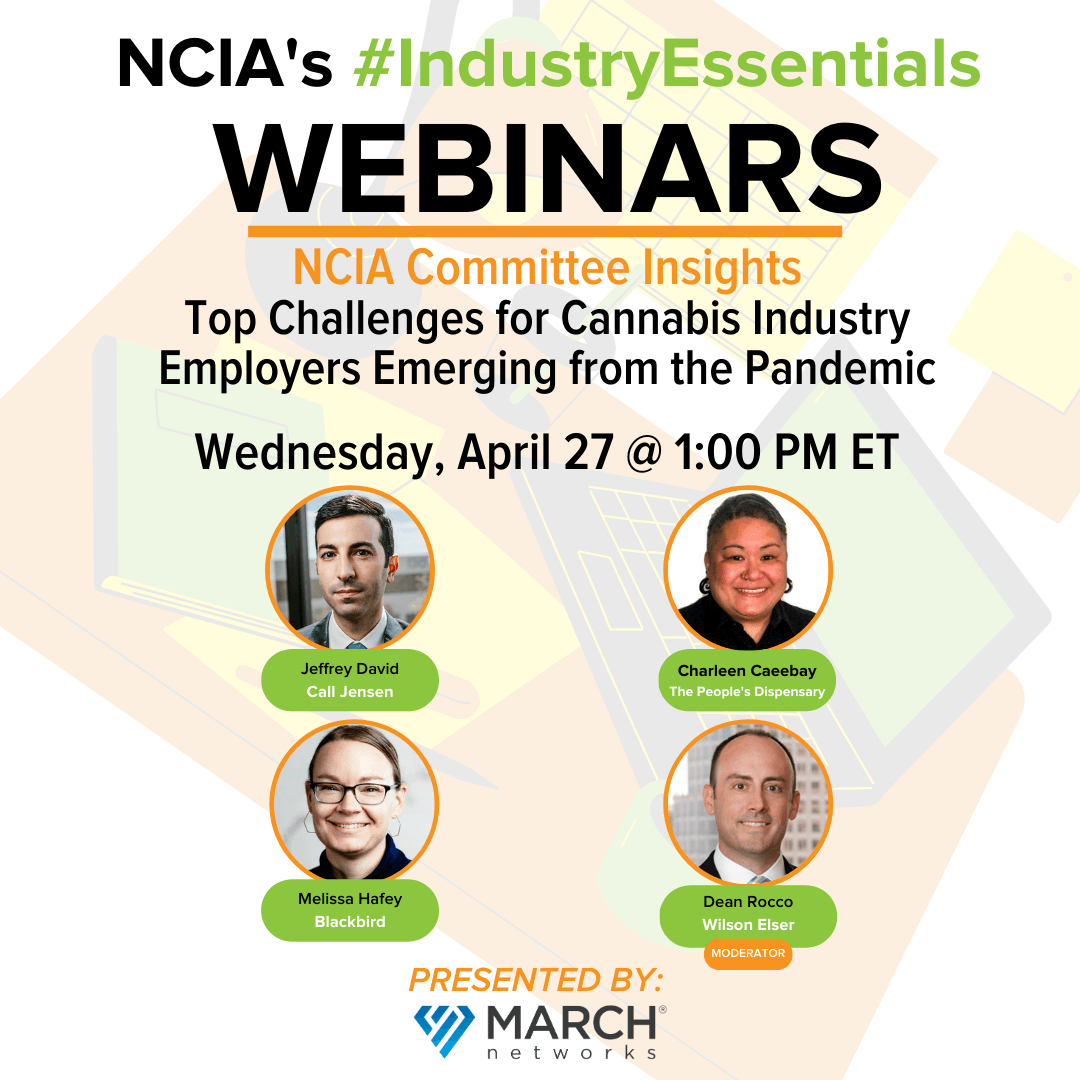
In this edition of our Committee Insights series originally aired on Tuesday, April 27, 2021 members of NCIA’s Human Resources Committee convened a panel of human resource and legal experts to lead a discussion on the pandemic’s impacts on the workplace and explore the challenges facing cannabis businesses emerging from the pandemic.
During this program, speakers provided practical considerations for reducing potential liabilities for remote and returning workforces. The session will also walk attendees through key considerations for administering vaccination policies while also highlighting areas of suggested focus beyond the pandemic response as businesses increasingly return to fuller operation.
Speakers:
Dean Rocco
Partner
Wilson Elser
Melissa Hafey
Director Of HR
Blackbird
Jeffrey David
Shareholder
Call Jensen

In this edition of our Policy Council Conversations series originally aired on Wednesday, April 21, 2021 we were joined by the authors of the recently-released white paper series entitled “Building New Foundations in the Cannabis Industry: Creating Gender Parity through Ownership, Leadership, Boards, Pay Equality, Branding, and Capital”, for a discussion in partnership with NCIA and the Arcview Women’s Inclusion Network.
In celebration of 4/20 and in honor of those that have come before us, this webinar will dive into the toolkits and the outcomes that will create Gender Parity, through Ownership, Leadership, Boards, Pay Equality, Branding, and Capital.
Are you a leader (or aspiring leader) in the cannabis industry? Is Diversity, Equity, Anti-Racism and Inclusion on your priority list? This webinar will be getting these big ideas into actionable takeaways.
The authors discussed the state of the industry and how businesses and individuals can embrace gender parity every day. The research, data, personal stories and case studies highlighted demonstrate why gender parity is crucial to business success in any industry, especially cannabis.
Have you read the papers? Listened to the podcasts? Just want to learn more about the topic? Everyone is welcome!
Download the series of papers (free of charge) and watch the introductory webinar here: https://arcviewgroup.com/ncia-papers/
Listen to the series of NCIA podcasts introducing these topics: https://thecannabisindustry.org/ncia-news-resources/podcasts/
Panelists:
• Christine De La Rosa, CEO & National Co-Founder, The People’s Dispensary
• Gail Rand, CEO & Founder, grand consulting, LLC
• Jessica Billingsley, Chairman of the Board & CEO, Akerna Corp.
• Risa Lavine, Chief of Staff, CohnReznick
• Kelly Perez, CEO& Co-founder, kindColorado
• Elise Serbaroli, Director of Global Business Development, Strimo
• Nancy Whiteman, CEO, Wana Brands
• Andrew Kline, Senior Counsel, Perkins Coie
• Allison Pugina, Category Manager, Canopy Growth Corporation
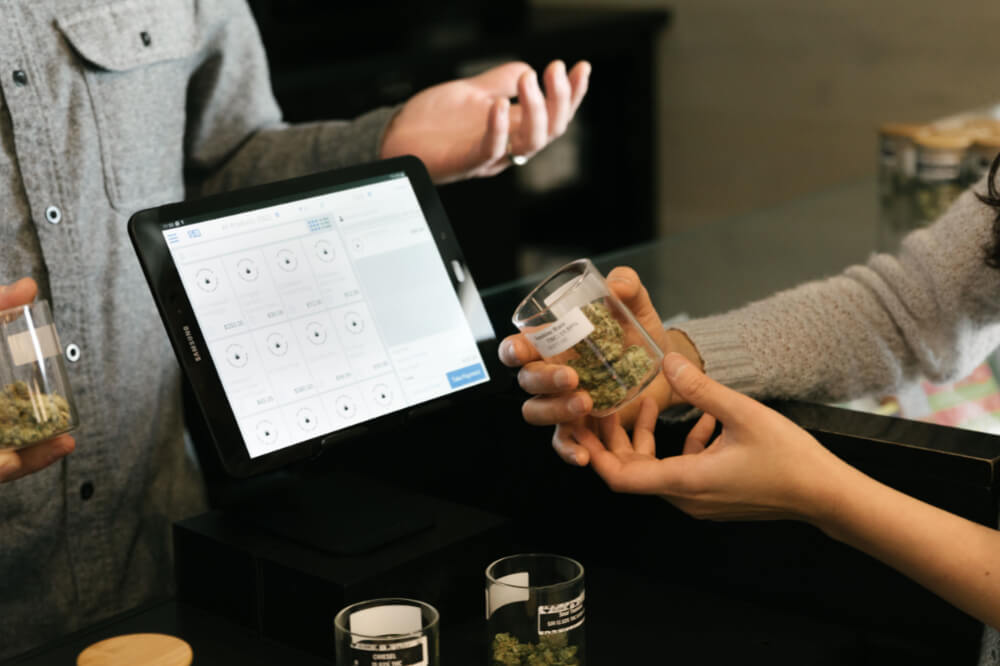
by Gary Cohen, Cova Software
The Canadian cannabis industry has witnessed great success since federal legalization in 2018. In the United States, 35 states authorize the use of medical cannabis, and 15 of them allow recreational marijuana consumption. Potential dispensary owners should bear in mind that the cannabis industry operates under strict laws and regulations that set this business apart from conventional retail operations. A robust point-of-sale (POS) system is one of the most important tools that a dispensary owner must invest in. However, it’s also crucial to remember that not all POS systems are created equal, and a cannabis industry-specific POS will always be a better choice than a generic POS. Following are some of the most important criteria that you should consider when selecting a cannabis POS:
A cannabis-specific POS created specifically to address the nuances and pain points of cannabis businesses is your best bet. A well-designed system helps you quickly process actual sales and facilitate better inventory management. An intuitive and easy-to-use system boosts the performance of your budtenders by making product information and customer data available to them on the fly, thus elevating the overall customer experience as well.
Compliance is the number one administrative burden dispensaries have to deal with because of the stringent laws and scrutiny the cannabis industry has to undergo. A well-executed cannabis-specific POS system empowers owners to stay compliant at every stage of their business. Most states in the US require tracking of inventory and sales through a state-mandated traceability system such as Metrc or BioTrack. Even among cannabis POS systems, the level of integration with the government tracking system varies, with many offering only batch reporting at the end of the day. Choose a POS that automatically sends every reported transaction in real-time to the tracking system, thus helping you minimize human errors and always stay fully compliant. Many legal cannabis markets also require digital age verification scanners for dispensaries to scan IDs at the point of entry. So ensure that your POS provider provides all these functionalities.
There have been instances of generic POS crashing when used by cannabis stores. Even popular cannabis-specific POS systems have had recurring performance issues. Learn more about each of the POS systems in consideration by reading reviews and customer stories to figure out how reliable they are. A cloud-based POS system entails storing data on remote servers operated and maintained by a third party. It poses a lower technical barrier to entry and is definitely a cost-effective solution, but you must ensure that your POS provider protects all your dispensary and customer data, as per government regulations.
A well-designed POS system offers inventory valuation and costing methods integrated into your POS to streamline your inventory management. A dispensary-specific POS will provide you the sales trends data you need to most accurately judge the weights, strains, and quantity of products you need to stock up. Many states in the U.S. expect you to have a clear paper trail on every legally grown gram of cannabis, from seed to sale, and your POS system must have efficient reporting capabilities for you to report that. Powerful analytics and a customizable mobile reporting dashboard will enable you to monitor the health of your store and submit reports in real-time from anywhere.
How your dispensary POS integrates with your other services and technology is another factor. Consider all the physical hardware that is being used in various sections of your dispensary and whether the POS provider can sync them with its software. You will have to integrate your accounting, HR, workforce, and security software solutions with your POS as well to ensure smooth operations. In a fast-evolving industry, new platforms and innovative solutions can hit the market almost overnight, but you must only select a POS that seamlessly integrates just not with your hardware and software but also with online marketplaces like Leafly, Weedmaps, and Dutchie so that you can offer easy pickup and delivery services to your customers as well.
A cannabis-specific POS company that has extensive experience in the industry will remain an authority on the latest developments, and will regularly update its product to stay ahead of regulatory changes. Find out about the after-sales customer support system they have in place- many companies will help you launch quickly but will disappear when problems may arise and leave you to tackle software glitches on your own. Also, choose a dedicated system for your retail business that specializes in the cannabis sector you operate in and is not an all-in-one solution.
An enterprise-level POS allows you to manage stock across all stores, set up location-level pricing, perform bulk editing, and even assign granular employee security permissions. It gives you complete visibility and full corporate control of your business with centralized reporting- accessible from anywhere, on any device. A POS built for multi-location brands has a robust platform with open APIs to enable flexible, plug-and-play integrations for easy scalability. Choose a POS provider that has the cannabis industry expertise and the ability to grow with you. Even if you may have to pay a bit more upfront, you will benefit from the long-term ROI and reduce your overall cost of ownership.
This is not an exhaustive list of points to consider. Download your free copy of ‘10 things to consider when choosing a point of sale system for your cannabis dispensary’ guide by Cova Software, which will offer you comprehensive information and help you choose the right POS.
Gary Cohen is the CEO of Cova Software, the fastest growing technology brand in the cannabis industry. Cohen’s focus has been driving the company’s overall strategy, including its vision, go-to-market plan, and strategic development. Since joining the cannabis industry in 2016 and launching Cova commercially in 4q17, Cohen has led Cova to dominate the enterprise sector for dispensary Point of Sale, while forging client relationships with hundreds of single-store retailers across North America.
Cova designs and builds retail software solutions specifically for the cannabis industry. Our technology platform currently powers 20,000 retail stores and over 1000 cannabis dispensaries with virtually no downtime, even on 4/20, making us the most robust and reliable cannabis POS system available on the market. Our point of sale system and its suite of digital solutions make complex operations simple, so retailers can stay compliant, streamline their operations and deliver an amazing experience always.

By Matt Finkelstein, BlueFire Cannabis by FutureSense
We are pleased to announce the release of the 2021 Cannabis Compensation Survey Report. This second annual survey aggregates compensation data for cannabis businesses and ancillary services, establishing benchmarks to help those businesses better understand the market and stay competitive, all while following federal compliance regulations that guide the collection and dissemination of compensation survey data and results.
FutureSense and NCIA laid the foundation for the project in 2019 and released results for the inaugural survey at the end of that year. At the onset of the pandemic in early 2020, both parties took a step back to adjust their trajectories looking to enhance the scope and depth of the project. Marijuana Business Daily came on as a primary partner to assist with visibility and distribution. Green Leaf Payroll & Business Solutions came on as a supporting partner, providing the project with anonymized payroll data. NCIA has stayed on as an endorsing partner to promote the shared mutual interest of supporting cannabis businesses and the industry at large.
This year, the survey established benchmarks with reportable data for 98 unique positions, a jump up from the inaugural report, which included 78 positions. The benchmarking process also established more accurate job titles representing both specific job responsibilities as well as representing the scope and breadth of organizational structures within the cannabis industry. These benchmarks include close to 200 unique positions total that will be reported on as the project grows and more cannabis organizations participate and submit data in future years.
The final report also includes recent trends and observations connecting the data to anecdotal insights found through our work and involvement in the cannabis community. The final report also provides information about how to utilize the survey data and a “geo-differential” chart to inform making any adjustments by state. The results are presented as percentiles to show both central tendency and spread. They are meant to be used as ‘guideposts’ to help inform salary and wage decisions, rather than exact numbers to base those decisions on. Many factors can and should be taken into consideration when determining what and how to pay employees, but these results provide an accurate representation of what pay amounts can be.
As the survey evolves and more companies participate, the project plans to also produce results with demographic breakouts such as by region/location, industry sector, and company size; as well as data for benefits, incentives, and equity compensation. These are all very valuable insights but require more participation across the country to produce, per compliance regulations.
The results from the survey can be used across every facet of the cannabis business. Understanding not just how to pay your employees, but also how to attract, motivate, engage, and retain your employees through compensation can be make-or-break in this rapidly evolving industry. 60-70% of companies’ expenses are typically payroll; being even 5% on- or off-the-mark could mean thousands or hundreds of thousands of dollars lost or gained.
The survey’s success is contingent on participation. More and more companies are realizing the value of this information and the importance of transparency through 3rd party surveys. All submissions and their respective data are held in strict confidentiality. Abiding by the Department of Justice regulations, this survey produces anonymous and unbiased results.
The survey accepts organization-wide submissions for companies with ten or more employees at this time. Individual submissions are appreciated as anecdotal insights, but are typically not included in data calculation.
For more information and to download your copy of the survey, please visit: https://content.futuresense.com/2021cannabiscompensationreport
For any questions and/or to sign up for next years’ survey, please email matt@futuresense.com or visit: www.BlueFireCannabis.com
 Matt Finkelstein is a consultant with BlueFire Cannabis by FutureSense. He has worked in the management consulting world since 2007 while also pursuing a passion for and career in organic farming. His farming experiences span across the many facets of the cannabis industry, lending itself to unique perspectives supporting his current work bringing FutureSense’s services to the cannabis industry and its community.
Matt Finkelstein is a consultant with BlueFire Cannabis by FutureSense. He has worked in the management consulting world since 2007 while also pursuing a passion for and career in organic farming. His farming experiences span across the many facets of the cannabis industry, lending itself to unique perspectives supporting his current work bringing FutureSense’s services to the cannabis industry and its community.
BlueFire Cannabis is the cannabis-forward division of FutureSense LLC, a management consulting firm providing holistic people strategies that improve business performance. Our specialties include business strategy, motivation and rewards, executive, employee and sales compensation, organizational and individual assessment, leadership development and coaching, human resources, communications, change and sustainable transformation. For more information, please visit www.BlueFireCannabis.com and www.FutureSense.com

 by Madeline Grant, NCIA’s Government Relations Manager
by Madeline Grant, NCIA’s Government Relations Manager
The Secure and Fair Enforcement (SAFE) Act, or H.R. 1996, passed the U.S House of Representatives with a final recorded vote of 321-101. This is the first floor action on a cannabis reform bill this Congress. This is not the first time we’ve seen movement on this bipartisan piece of legislation that would protect banks that service state-legal marijuana businesses from being penalized by federal regulators. The bill was reintroduced in March by Reps. Ed Perlmutter (D-CO), Steve Stivers (R-OH), Nydia Velazquez (D-NY), and Warren Davidson (R-OH), and had 177 total cosponsors by the time of the vote. The bill was taken up under a process known as suspension of the rules, which requires a 2/3rd supermajority to pass and does not allow for amendments. This is the fourth time that the House has approved the language of the SAFE Banking Act, initially as the first standalone cannabis policy reform bill ever passed by either chamber of Congress in 2019 and two more times last year as part of pandemic relief packages that were not approved in the Senate.
The SAFE Banking Act would protect financial institutions from federal prosecution for providing banking and other services to cannabis businesses that are in compliance with state law, as well as help address serious public health and safety concerns caused by operating in predominantly cash-only environments. The legislation would improve the operational viability of small businesses by helping them reduce costs associated with lack of access to banking and increasing options for traditional lending that many small businesses in other fields rely upon. It would also mandate a study on diversity in the cannabis industry.The SAFE Banking Act seeks to harmonize federal and state law by prohibiting federal banking regulators from: threatening or limited a depository institutions access to the Deposit Insurance Fund, discouraging, prohibiting, or penalizing depository institutions from dealing with the cannabis industry, taking any action against a loan made to a covered business and forcing a depository institution to halt providing any kind of banking services.
Legislation to provide safe harbor for financial institutions that choose to service the cannabis industry was first introduced in 2013 and was called the “Marijuana Businesses Access to Banking Act.” When the bill died in Congress, it had 32 cosponsors and no Senate companion legislation. The bill was reintroduced in 2015 with the same name and 39 cosponsors and a Senate companion with 11 cosponsors.
In 2017, the bill was reintroduced and renamed the Secure and Fair Enforcement (SAFE) Banking Act. By the end of that session, the bill had 95 cosponsors and the Senate companion bill had 20 cosponsors.
On March 7, SAFE Banking was introduced in the House by Rep. Ed Perlmutter (D-CO) and was referred to the Judiciary and Financial Services Committees. On March 28, 2019, the Financial Services Committee voted 45 to 15 to advance the bill to the full House. The bill had broad bipartisan support with 153 cosponsors, over a third of the entire House, at the time of the committee vote (a major jump from 2017). On April 1, Senator Jeff Merkley (D-OR) introduced a companion bill to the Senate and the bill was referred to the Senate Banking, Housing, and Urban Affairs Committee. On June 6, the House bill moved out of committee and was placed on the Union calendar for a vote. The bill then passed the House by 321-103.
Congress spent 2020 legislating relief legislation for Americans as the coronavirus took a toll across our nation. SAFE Banking language was also included in two coronavirus relief packages that the House approved, but unfortunately, did not make it through the Senate.
One thing is abundantly clear, states are continuing to legalize cannabis and the federal government must mitigate the state and federal conflict that legal cannabis businesses are facing. Access to banking is not only essential for any business to function, but a necessary measure for public safety. Laws making cannabis legal for adults have been passed in 18 states as well as the District of Columbia and the territories of CNMI and Guam, and 36 states, as well as several territories, have comprehensive medical cannabis laws. As the House of Representatives, again, has passed SAFE Banking, we will turn our focus to the Senate and keep up the momentum. Make sure when you have a few minutes call your senators and urge them to support the SAFE Banking Act, S. 910. You can look up your senators’ information HERE.

 by Fred Whittlesey, Founder and President, Cannabis Compensation Consultants
by Fred Whittlesey, Founder and President, Cannabis Compensation Consultants
Member, NCIA Human Resources Committee
with assistance from
Kara Bradford, Co-Founder & CEO, Viridian Staffing
Chair Emeritus, NCIA Human Resources Committee
All high growth companies face the same challenge: Hiring high-quality people at a feverish pace, while dealing with all of the issues that come with that including recruiting, onboarding, training, and of course, compensation.
The cannabis sector (more than just an “industry”) has another layer of challenges rarely seen when finding and hiring the employees needed for the explosive growth underway:
The cannabis product lifecycle, like any consumable product, spans agriculture, processing, packaging, branding, distribution, and direct sales. A fully vertically-integrated company might employ, within a single corporate entity, agricultural workers, lab workers and extraction specialists, manufacturing workers, distribution teams, and dispensary employees. That is a challenging environment for compensation plan design.
For example, agricultural workers, including agricultural managers, virtually never receive equity compensation as an element of their pay package. Biochemists, particularly when coming from a biopharma company, expect significant equity compensation. Retail dispensary managers, no equity. VP of sales, equity.
Now, imagine those jobs and people are spread across multiple entities. Maybe the overall corporate structure is a C Corp over some LLCs. Or, like in Arizona, a nonprofit corporation with a Management Services Agreement with a C Corp which directs money through an LLC.
Or in British Columbia which, like the U.S., prohibits alcohol and cannabis sales in the same stores or from the same company, but has owners that operate in both businesses. And the stores are next door to each other. Budtender vs. sommelier? Employees talk.
But perhaps the most compelling reason to consider a broad spectrum of compensation alternatives is unique to cannabis: The non-deductibility of compensation expenses that cannot be characterized as cost of goods sold — Tax Code Section 280E. More than in any other industry, using forms of compensation that avoid incurring a nondeductible compensation expense can have a direct and immediate impact on business financial performance.
Complex cannabis companies have to mold their pay programs to fit this broad array of entities, lines of business, and types of jobs, under an unfavorable tax environment.
There are four, and really only four, types of compensation for employees (and independent contractors, and members of the Board of Directors, and consultants). Each of the four has many forms, but there are four types of things a company can do to pay — and hopefully continue to pay — an employee. This is a useful framework for thinking about compensation.
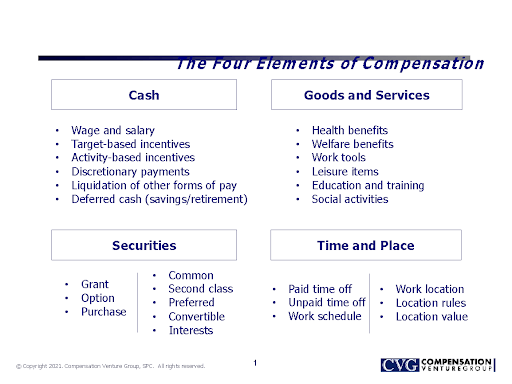
Wage, salary, performance incentives or bonuses, commission, 401(k) contribution (yes, a cannabis company can have a 401(k)), profit sharing, retention bonuses. Every employee will receive one or more of these forms cash payments. All require cash changing hands from the company to or on behalf of the employee.
The most common cash compensation arrangement is a base salary plus bonus as a percentage of salary that is typically dependent upon the performance of the individual, team, and/or company. Many companies have a 10% of base salary target. In the cases of budtenders and delivery drivers, tips (essentially a customer-paid commission) are common as compensation as well. Companies in some locations, such as California, continue to pay trimmers at piece rates (pay by unit production).
I casually call this category “stuff” — a company gives people stuff as part of their compensation. Healthcare coverage, life insurance, job training, a laptop and a phone in the traditional model. But this category includes much more than traditional “employee benefits” — from free food to use of the company vacation home to sabbaticals, these meet employees’ needs while keeping them focused on, and sometimes physically at, work. Sometimes this free stuff is not taxable income to the employee (healthcare coverage, free food at work) and sometimes it is taxable (free gym membership). Be informed in your creativity here. Local regulations in many jurisdictions are dictating benefits coverage above the federally-mandated level.
This is by far the most complex form of compensation, and more so for cannabis companies. Whether it’s stock options, restricted stock, restricted stock units, or member interests (in an LLC) — the question is which entity is granting the compensation, and whether they are allowed to grant it to an employee in a different entity. We are beginning to see companies that compensate employees with cryptocurrency which is viewed as a “security” by both the IRS and SEC. Given the increasing social justice emphasis in the cannabis sector, equity compensation is the form of pay that truly levels the playing field across all income levels.
The choice of equity compensation will be driven by the form of organization and ownership philosophy.
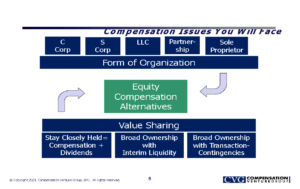
Before COVID-19, companies in all industries were increasingly emphasizing this form of compensation. In the 1980’s, there was no “casual dress” and “working from home” was unheard of. An employee reported to the workplace at the assigned time, and there was no “flextime.” Over the past few years, companies were already experimenting with paid parental leave, unlimited vacation time, and employee-choice work location. Now, for many companies and many jobs, WFH is the model. Not for growers and not for budtenders (yet). But time and place can be highly valuable cash-free (sort of) equity-free forms of compensation.
Hiring is only half the battle. Retention of employees in the cannabis sector is as challenging as hiring. Companies need to be creative with the same four tools to retain employees. But you can’t wait until they give notice of resignation, because then it’s too late.
Your employee retention compensation program starts at the employee’s date of hire, because it is the same program.
_________

Cannabis Compensation Consultants (TM) , owned by Compensation Venture Group SPC (CVG) helps companies design and implement compensation programs that balance diverse stakeholder needs, under its Conscious Compensation© model. CVG specializes in working with startups and early stage companies in this complex regulatory environment.

 by Deborah Johnson, MCA Accounting Solutions & James Whatmore, MAB Investments
by Deborah Johnson, MCA Accounting Solutions & James Whatmore, MAB Investments
NCIA’s Banking & Financial Services Committee
Part 2 of a 3-part series
In our first part of this blog, we discussed the very beginnings of a company; an idea, gathering a team around you, self-funding, opening a bank account and forming an LLC or incorporating. Now you are ready to take a big step, bring on some more people, purchase more equipment and explore partnerships. You have a path with real milestones. This is the time to plan a funding strategy.
If you are not plant-touching, or you are directly ancillary, you might be able to secure a bank loan or an SBA loan. As the SAFE Banking Act is being considered in Congress (at time of writing) the reality of greater access to cannabis banking services may be getting brighter. However, traditional banking sources may still be an issue. These challenges have blended into some ancillary activities. There are a few other debt instruments including venture debt, an accounts receivable (AR) line, or an asset loan. Some of these instruments can be originated with specialty firms or other investment sources.
“While debt has traditionally been scarce in our industry, the relatively recent arrival of lenders has fortunately changed the construct of cannabis company balance sheets. Industry normalization, low rates, relatively high equity capital costs and supply-demand imbalances have attracted capital pools into credit and provided companies with the ability to further normalize their blended cost of capital,” said Sumit Mehta, founder and CEO of Mazakali and chairperson of NCIA’s Banking & Financial Services Committee.
Recently Harborside Inc. (CSE:HBOR) (OTCQX:HBORF) in California landed a historic $12 million revolving line of credit with a bank, marking the first time a cannabis touching company has secured this kind of access. Granted it is secured, but it is a commercial loan from a traditional lender. If you have real estate involved many investors will do a sale leaseback on the property to provide some liquidity. Equipment may also secure a loan; this is often a choice to outfit a capital-intensive production. When evaluating your debt options consider what is happening at this point in your life cycle. For an early-stage company, a revolver may not be the right fit; however, having the right equipment getting you to revenues might be worth investigating.
There are also grants available. Especially with COVID-19, many local jurisdictions are providing small business grants, or you might find one aligned with your demographic or target market niche. Many startups find an accelerator or incubator to help both fund and scale the company. In cannabis, the accelerators have historically been targeted to the ancillary market. Several exist, including Canopy Boulder, Momentum, Gateway, Hood Incubator, The Initiative, Cannabiziac, and even traditional market accelerators such as Y Combinator are addressing the needs of the cannabis market. Accelerators will invest in the companies they are providing guidance to and are generally hosted over a short period of time like 3-4 months, whereas an incubator provides resources, networks, and services over an 18+ month time and might charge a fee to participate. This early mentoring is a great resource for social and personal capital as well. If you have participated in an accelerator or incubator environment you should be exposed to early-stage investors; if you haven’t been exposed to them, this is the time for a solid PowerPoint deck and to polish your presentation.
Next on the list are angel investors. Angels are those individual investors that provide early-stage funding for a startup usually in exchange for convertible debt or ownership equity but are not locked into a funding structure. Banks make loans, angels can do as they please. They can be sophisticated or unsophisticated as they technically just need to qualify as an accredited investor. Most are drawn to investing in something familiar, so either they have a direct professional background in your industry or have felt the pain point you are addressing personally. Some want to roll up their sleeves and be engaged in helping your company grow, others just want to diversify their investment portfolio and take a more passive role. They can invest in the idea and direction of the company and a good angel will understand the timing of the investment. This means that early-stage investors like angels and funds should understand that this is a long-term investment that might take 5-8 years to see liquidity.
The greatest challenge to an entrepreneur is where to find them. Sometimes it’s as easy as looking around your network. With some work you can attract attention to your business idea by either presenting/speaking or pitching at a conference. Over the years, many opportunities to do so have developed. NCIA hosts CannaVest and Cannabis Business Summit, one of the longest running is The Arcview Group, Benzinga, IC3 by IMN, CWCBExpo and many cut their teeth at MJ Biz. Angels are individuals, but often belong to a group of angels to assist with deal sourcing and due diligence. With the normalization of cannabis, you can find many groups via the Angel Capital Association. We’d suggest reviewing market transactions and see who is announcing that they secured funds and with whom. You can find this information through keywords and press releases, consolidating sites such as New Cannabis Ventures or Viridian Capital Advisors, or even Pitchbook. This is the hard part of fundraising: connecting with the right investors.
You can also gain exposure to investors by sharing your expertise. Whether it’s articles on LinkedIn or podcasts and panels, exposing your knowledge of your niche is critical to gaining their confidence in your ability to execute. The conferences above may host your presentation as well furthering your investor engagement. One word of caution, there is a new platform being used by millions – even though it’s still in beta – called Clubhouse. There have been many people that are running pitch rooms on that platform and they are running up against the SEC and rules for fundraising. We encourage an extra dose of caution when pitching where you don’t understand who your audience is and if they adhere to qualifying factors. Many times, the later investors (Series B or C rounds) have to do a lot of work to clean up the cap table from earlier investment rounds. That can be a hurdle that an investor might walk away from. So, the more you can do to assure you are running a clean and efficient fundraising round, the better.
Given that we are in the cannabis industry, it is of particular importance to be an advocate. Access to this plant is still restricted for many, people are still going to jail or are still in jail, and businesses have a disadvantage to all other industries given the repercussions of federal illegality. So being an advocate, aligning and engaging with advocates like the National Cannabis Industry Association (NCIA), Marijuana Policy Project (MPP), Students for Sensible Drug Policy (SSDP) and others, can also expose you to investors who recognize your understanding that there is much work to be done to assure fair access. Expertise, Advocacy, and Engagement will build your social capital. The early rounds can hinge on these factors. While you will need a proforma, other financials and a solid plan, an angel is investing in you as much as in your current project. With enough social capital, your relationship with the early angel investor will survive major setbacks.
Once past these early rounds, your focus will turn to more formal investment groups and businesses in private equity, venture capital and then the public market. Currently those companies touching the plant are able to be hosted on the OTC (over-the-counter) market or the CSE (Canadian Stock Exchange) with a growing number of ancillary companies listing on the traditional exchanges. Here there will be a deep dive into the numbers and execution, pre/post revenues with a clear runway to real revenue. This requires an adaptive corporate culture with some loss of control expected.
In our final piece of the series, we will review crowdfunding, tips on angel and fund investors, and types of funding.

NCIA Deputy Director of Communications Bethany Moore checks in with what’s going on across the country with the National Cannabis Industry Association’s membership, board, allies, and staff. Join us every Friday on Facebook for NCIA Today Live.

by Aaron Smith, NCIA’s CEO and Co-founder
Today, 70% of Americans support the end of cannabis prohibition and almost four in every ten adults have access to regulated, legal cannabis for their own use — no questions asked.
We are on the precipice of the end of federal prohibition, with even the Senate Majority Leader calling regularly for his chamber to advance legislation that would legalize cannabis. In 2012, when Colorado voted overwhelmingly to amend their constitution to create the adult-use cannabis industry, it seemed incredibly unlikely – even in that moment of success – that we’d see the explosion in progressive policy and normalization coast-to-coast in marijuana that we have.
For those that were fortunate to know Steve Fox, though, our present felt more like an inevitability than anything else. Remembered as an energetically empathic and enthusiastic advocate, anyone who has enjoyed any part of the legal cannabis boom owes a moment of peace to Steve’s memory.
Steve was one of the first political power players to turn their attention to cannabis, long before it was polling at a place where prominent politicians were tripping over themselves to attach themselves to 420-friendly policy. Building on momentum from the medical cannabis movement and championing the personal liberties being accosted by the overcriminalization of cannabis, he had an immediate and lasting impact when he arrived on Capitol Hill.
In 2002, only five years after the first state decriminalized cannabis for medical use, Steve was the lone full-time cannabis lobbyist in Washington, D.C., pushing for federal reform in our nation’s capital on behalf of Marijuana Policy Project. He answered the call for justice long before most others heard it, championing cannabis as a proxy for his own views on societal justice and individual freedom.
Dedicated to a clear set of righteous ethics, armed with his passionate voice for sensible reform, Steve worked incredibly hard and with every tool at his disposal to do the right thing, in the correct way. While drafting and campaigning for Colorado’s Amendment 64, which would be the nation’s first to legalize cannabis for adult use, Steve never took his eyes off the need for succinct and coordinated efforts for the community that would grow in a patchwork across a country opening their markets state by state.
It was in 2010 that he and I, fellow Marijuana Policy Project alums, set out to answer that call for a single voice to speak on behalf of the emerging industry and founded the National Cannabis Industry Association. Recognizing that his incredible energy, rarely slowed, would serve best in his lobbying efforts, Steve opted to become the first Secretary of the NCIA Board of Directors and worked with and around — though never in — his own organization for the next decade.
At the time, after the release of the Ogden Memo by the U.S. Justice Department directing prosecutors not to prioritize the use of federal resources to prosecute patients with serious illnesses or their caregivers who are complying with state laws on medical marijuana, cannabis policy was wide open.
An industry association, uniting all voices and allowing for progressive policy to be pushed in a single stroke, remains only one of Steve’s legacies. Though his work is unfinished, we are all fortunate that he inspired dozens of passionate activists, lobbyists, and policy writers who are dedicated to seeing it done in his memory and with his spirit.
If you’ve enjoyed any of the benefits of legal, regulated, adult-use cannabis — whether it is your own personal consumption, better schools from taxes, a safer neighborhood — please consider contributing to the GoFundMe set up by VS Strategies to support his wife and daughters in this difficult time.
This site uses cookies. By using this site or closing this notice, you agree to the use of cookies and our privacy policy.
Follow NCIA
Newsletter
Facebook
Twitter
LinkedIn
Instagram
News & Resource Topics
–
This Just In
Committee Blog: Cannabis and Cardiovascular Disease
Rooted in Community: Fox Rothschild